EDITOR’S NOTE: Please be advised that this Kyoto travel guide hasn’t been updated in 2024. Prices and travel guidelines may no longer be accurate so it’s important that you verify any information before proceeding.
Kyoto is my favorite city in Japan. It always has been. I’ve visited many cities and prefectures through the years but Kyoto remains my favorite destination in the country.
Tokyo and Osaka are more exciting but Kyoto has everything I love about this fascinating country. Slower and more deliberate in pace, it’s an atmospheric city that makes you feel like you were in a different time in Japan.
Kyoto is a city of Buddhist temples and Shinto shrines, of geishas and landscaped gardens far removed from the sensory overload of Harajuku and Akihabara. Don’t get me wrong. I enjoy video games and otaru culture too. But when I imagine all the things I love most about Japan – atmosphere, tradition, culture, and food – I see Kyoto.
There is so much to see and experience in this city long regarded as the historical and cultural heart of Japan. If you’re visiting Kyoto for the first time, then I hope this travel guide helps you fall in love with this city as much as I have.
VISIT KYOTO QUICK LINKS
This travel guide to Kyoto is long. For your convenience, I’ve compiled links to hotels, tours, and other services here.
HOTELS
Top-rated hotels in Higashiyama, one of the best areas to stay for first-time visitors to Kyoto.
- Luxury: Luxury hotel SOWAKA
- Midrange: Rinn Gion Yasaka
- Budget: Gion Kyoto Miyagawacyo Guesthouse HANAKANZASHI
TOURS
- Sightseeing Tour: Kyoto Day Tour
- Kimono Rental: One Day Kimono Rental
- Food Tour: 3-Hour Food and Culture Tour in Gion
- Kaiseki Experience: Kaiseki Course Meal at a Historic 250-year-old Restaurant
- Market Tour: Kyoto Nishiki Market Tour with 7 Course Lunch
- Cooking Class: Cooking Classes in Kyoto
OTHER SERVICES
- Visa Services
- Travel Insurance with COVID cover (WFFF readers get 5% off)
- Airport Transfers
- Kansai Thru Pass
- Japan Rail Pass
- Japan eSIM
Save This on Pinterest!
No time to read this Kyoto travel guide now? Click on the save button and pin it for later!
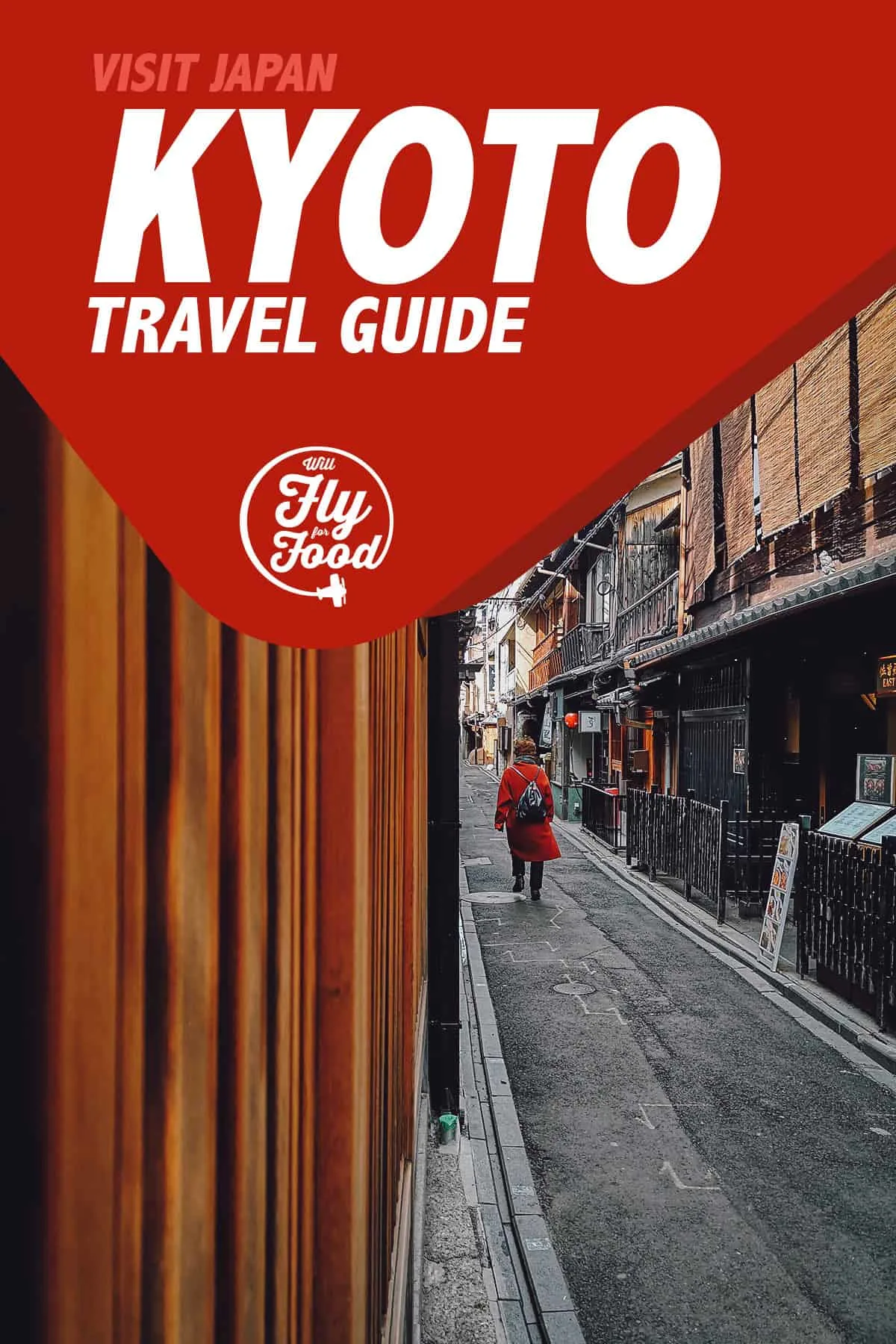
GUIDE TABLE OF CONTENTS
KYOTO TRAVEL RESTRICTIONS
Because of the current global situation, Kyoto travel guidelines seem to change on a daily basis. Our friends at Booking.com created a website that lists detailed information on travel restrictions around the globe.
Before planning a trip to Kyoto, be sure to check Booking.com for information on travel restrictions to Japan. If you do decide to visit Kyoto, then you may want to seriously consider getting travel insurance with COVID coverage.
JAPAN VISA
You may need a visa and other requirements to visit Japan depending on your passport. Check out iVisa.com to learn about the requirements and to apply for a visa (if necessary).
KYOTO AT A GLANCE
When people think of Japan, two cities usually come to mind – Tokyo and Kyoto. Tokyo may be Japan’s present-day capital but Kyoto held that distinction for over a thousand years – from 794 to 1868 – before control of Japan moved from the Shogun to the Emperor.
In spite of this shift in influence, many today still regard Kyoto as Japan’s cultural and historical center, home to over a thousand temples and gardens that have earned it a reputation for being the country’s most beautiful city.
We’ve visited many prefectures and cities in Japan through the years, but Kyoto remains one of the most special. It is without a doubt the heart and soul of traditional Japan.
BEST TIME TO VISIT KYOTO
The most popular times to visit Kyoto are during the Spring (March-May) and Fall (October-November) months when the weather is ideal and the landscape is at its most striking.
Both seasons are characterized by a dramatic change in color – Spring for its cherry blossom pinks and whites, and Autumn for its fiery reds, oranges, and yellows. Unlike its cold winters and hot summers, the weather is mild in Spring and Fall so either season would be the perfect time to visit.
If you’re interested in Kyoto’s festivals, then you can click on the link for a list of Kyoto’s annual festivals and events. It’ll give you a monthly breakdown of its weather as well.
DEC-FEB: This is the coldest time of the year in Kyoto. Unless you want to experience snow, then this probably isn’t the best time to go. I heard it snows a few times a year though the snow doesn’t stick.
MAR-MAY: This is one of the most popular times of the year to visit Kyoto. The weather is ideal. The cherry trees begin to blossom in late March and they’re usually in full bloom by the first week of April. Unsurprisingly, it’s also the busiest time of the year so expect larger crowds and steeper hotel prices. The same goes for the first week of May which is the Golden Week holiday for local Japanese.
JUN-AUG: This is summer in Kyoto. Crowds are thinner but it’s hotter and more humid, so it may not be the best time to go. It’s usually hottest in August and rainiest from June to July.
SEPT-NOV: Like spring, autumn is one of the best times to visit Kyoto. The weather is ideal and the autumn foliage is striking. We visited Arashiyama in late November and the fall colors were stunning.
Climate: Annual Monthly Weather in Kyoto
Check out holiday-weather.com for more on Kyoto’s weather. For your convenience, I’ve created the average temperature and annual rainfall graphs below. Suggested months to visit are indicated in orange.
Average Temperature
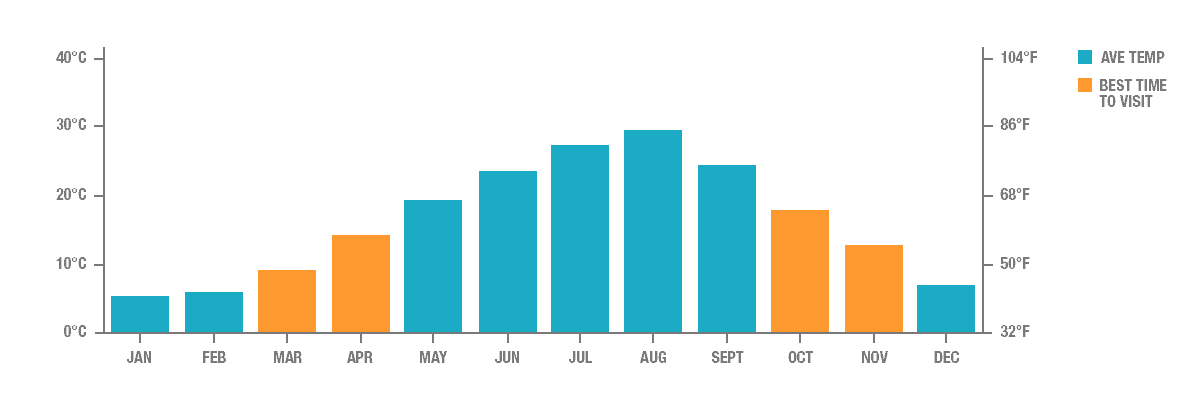
Annual Rainfall
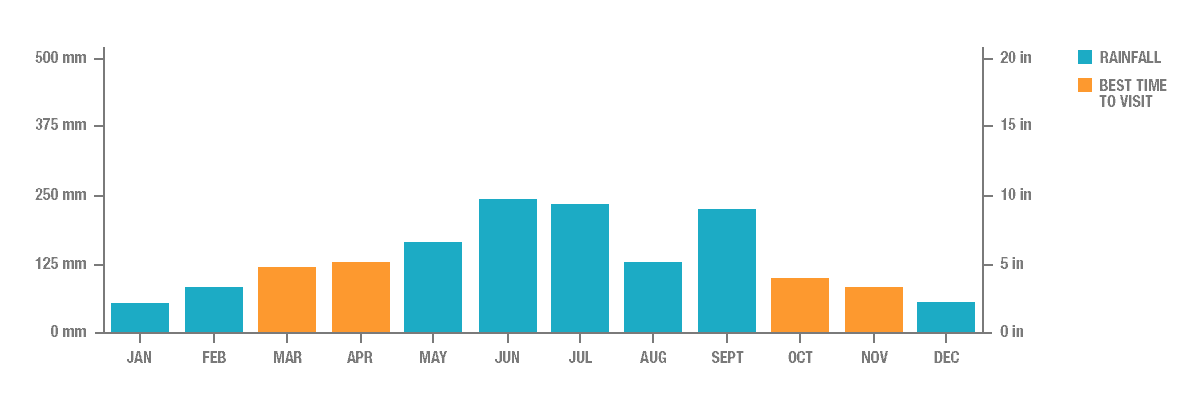
TRAVELING TO KYOTO
There are many ways to get to Kyoto depending on where you are. You can check Bookaway or use the widget below to find route options available to you.
From KIX
If you’re flying into Japan, then chances are you’ll be arriving at Kansai International Airport (KIX). Located in Osaka, it’s the main access hub to the Kansai area. Here’s how you can get to Kyoto from KIX.
BY TRAIN: The Limited Express Haruka Train is the only rail service from KIX to Kyoto station. It takes about 80 minutes. You can purchase tickets at the station but it looks like you can get a considerable discount if you buy them in advance through Klook.
It’s worth noting that some transportation passes are valid for travel between KIX and Kyoto. Jump to the HOW TO GET AROUND section of this guide for more information.
BY BUS: You can travel from KIX to Kyoto station by limousine bus as well. They operate on a 24-hr schedule so this may be the better option if you’re arriving at off-hours. The journey takes about 100 minutes. You can refer to the Kansai Airport transportation website for a timetable. Tickets can be purchased at the airport or you can get them in advance through Klook.
BY SHUTTLE: There’s a convenient door-to-door shuttle service that takes you from KIX to your hotel in Kyoto in about 2-2.5 hrs. You can make reservations on the Yasaka Taxi website. Advanced bookings are required.
BY TAXI: If you have a lot of luggage, then going by taxi is the most convenient option, but it’s also the most expensive. Expect to pay no less than JPY 30,000 each way.
BY PRIVATE TRANSFER: If you’d like to arrange for a private transfer, then you can do so through Klook.
From Other Parts of Japan
Japan’s railway system is so efficient and extensive that it’s easy to travel to Kyoto by train from other parts of the country. You can check hyperdia.com for train routes and schedules.
If you’ll be visiting multiple cities in Japan, then you might want to get a JR Pass. It’ll give you unlimited use of all JR national trains in Japan – including the Kansai Airport Express Haruka, Shinkansen bullet trains, and the Narita Express – for a consecutive number of days. JR Passes are available in 7-, 14-, or 21-day variants and can be purchased from Klook or Japan Rail Pass.
WHERE TO EXCHANGE CURRENCY
The unit of currency in Japan is the Japanese Yen (JPY).
BANKS / POST OFFICES: Banks and post offices are among the most reliable places to exchange foreign currency in Japan. However, the process is slow. I’ve exchanged currency at banks in different cities and there’s always paperwork to be filled out. The process can take time, up to 30 minutes in some cases.
KINKEN SHOPS: Kinken shops are small stores that buy and sell unused event tickets. Some of them also exchange currency. You can find kinken shops in major Japanese cities, usually near large metro stations. I exchanged currency at a kinken shop in Shinjuku and got great rates. In Kyoto, I read that the best kinken shop to exchange currency is the Tokai Discount Ticket Shop.
CURRENCY EXCHANGE MACHINES: I haven’t seen these too often but I did exchange currency through a machine in Nagasaki once. It resembles an ATM but you can use it to exchange currency. Just insert your foreign currency and out comes the JPY equivalent. So easy. I haven’t seen one in Kyoto but they may have them in popular tourist and shopping areas.
ATM MACHINES: This is our preferred way of getting JPY. Rates are often comparable and it saves us from the trouble of having to bring a thick wad of foreign currency to Japan. Just be sure to advise your bank that you plan on using your ATM card abroad so they don’t block any transactions. In my experience, my card works best at convenience store and post office ATMs in Japan.
TIP: Some ATM machines will ask you if you’d like to proceed “with or without conversion”. Always choose WITHOUT conversion. Proceeding “with conversion” allows the foreign bank running the ATM machine to do the conversion, usually at terrible rates. According to this article, the difference can be as high as 10%.
BEST AREAS TO STAY IN KYOTO
The downtown area and Higashiyama are the best areas to stay in Kyoto. They put you close to many restaurants, shops, and tourist attractions. Both of the city’s subway lines run through these areas, making it easy to get around.
To help you understand where all these recommended areas are, I’ve created the color-coded map below. Click on the link for a live version of the map. (Please note that marked areas are approximations only)
BLUE – Downtown / Central
RED – Around Kyoto Station
YELLOW – Northern Higashiyama
ORANGE – Southern Higashiyama
GREEN – Arashiyama
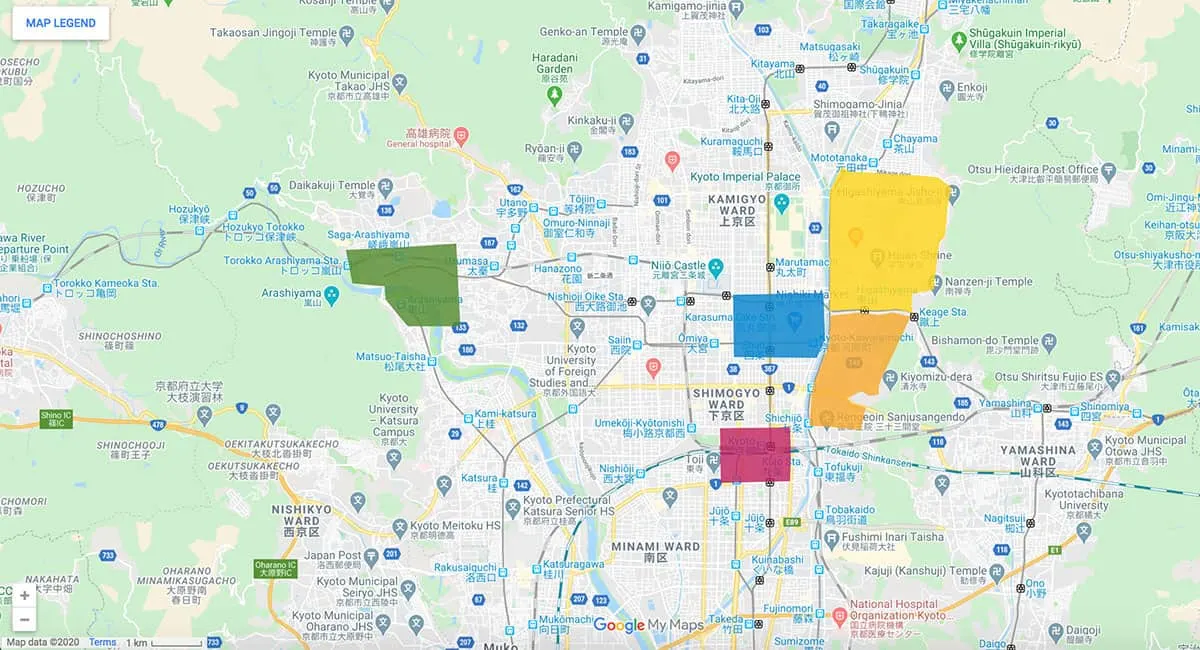
DOWNTOWN
As described, the downtown area is a great place to stay in Kyoto. It’s conveniently located with plenty of hotels, shops, restaurants, bars, and convenience stores.
Toyoko Inn is one of the biggest and most popular business hotel chains in Japan. Like all Japanese business hotels, the rooms are small but well-amenitized. You can book a room here on Agoda.
If you want to stay in downtown/central area but don’t feel this is the right hotel for you, then you can check for alternate listings on Booking.com or Agoda. Check out some of the top-rated hotels in downtown Kyoto:
- Luxury: Kyoto Shijo Takakura Hotel Grandereverie
- Midrange: Miru Kyoto Nishiki
- Budget: Guesthouse Yululu
AROUND KYOTO STATION
The area around Kyoto Station is another great place to stay in Kyoto. Kyoto station is the city’s main transportation hub so staying in this area will give you easy access to transportation around the city and to other parts of Japan. There are plenty of shops and restaurants here as well. Check these sites for listings around Kyoto station: Booking.com | Agoda. Here are some of the top-rated hotels in the area:
- Luxury: The Thousand Kyoto
- Midrange: Yamadaya Ryokan
- Budget: Kyoto Hana Hostel
HIGASHIYAMA
Across the Kamo River from central/downtown Kyoto is Higashiyama Ward. Divided into north and south, this area is home to some of Kyoto’s most popular attractions like Kiyomizu-dera, Yasaka Shrine, and Ninnen-zaka / Sannen-zaka streets.
Both Northern and Southern Higashiyama make great bases from which to explore Kyoto, though it’s best to stay as close as possible to the Gion district. I stayed at Shiki Shiki Higashiyama which is right at the border of north and south. It’s a clean and comfortable boutique inn in a quiet neighborhood in Higashiyama.
I paid about USD 30 a night for a 3-person private room with a shower. That’s USD 30 a night for the entire room! It may have been a little tight for three people, especially with all your luggage, but it’s perfect for two.
You can book a room at Shiki Shiki Higashiyama on Booking.com or Agoda. If you don’t think this is the right place for you, then you can check these sites for alternate listings: Booking.com | Agoda. Check out some of the top-rated hotels in Higashiyama:
- Luxury: Luxury hotel SOWAKA
- Midrange: Gion HANNA STAY
- Budget: Gion Kyoto Miyagawacyo Guesthouse HANAKANZASHI
ARASHIYAMA
Arashiyama is farther away from central Kyoto but it’s such a lovely area that it’s worth considering. It’s where you’ll find those iconic bamboo groves that people often post on social media.
Unlike the previous areas which are more densely populated, Arashiyama is quieter and closer to nature. It’s home to quaint shops and a few temples, most notably Tenryu-ji.
When searching for accommodations, I suggest looking for a ryokan (traditional Japanese inn) as this is the perfect environment for it: Booking.com | Agoda. Check out some of the top-rated hotels in the area:
- Luxury: Suiran, a Luxury Collection Hotel, Kyoto
- Midrange: サクラストーリー
- Budget: Mulan Hostel
You can also book hotels and home stays in Kyoto using the handy map below.
PLACES TO VISIT IN KYOTO
There is a LOT to see in Kyoto. You could spend an entire week there and still not see everything. Listed below are some of the city’s most popular attractions.
You can explore Kyoto on your own with a transportation card and lots of energy, but if you’d like to go with a guide and have transportation arranged for you, then you can choose from one of many Kyoto tours on Klook or Get Your Guide.
1. Kinkaku-ji (Golden Pavilion)
Kinkaku-ji is a UNESCO World Heritage Site and one of the city’s most memorable attractions. Covered in gold leaf, it’s easily Kyoto’s most striking temple. In fact, so stunning is Kinkaku-ji that it was once burned down by a schizophrenic monk who felt that it was “too beautiful”.
Check out my article on Kinkaku-ji for more pictures and information. We visited the Golden Pavilion on our own, but you may want to check out this guided tour. It takes you to Kinkaku-ji and other popular attractions in Kyoto.
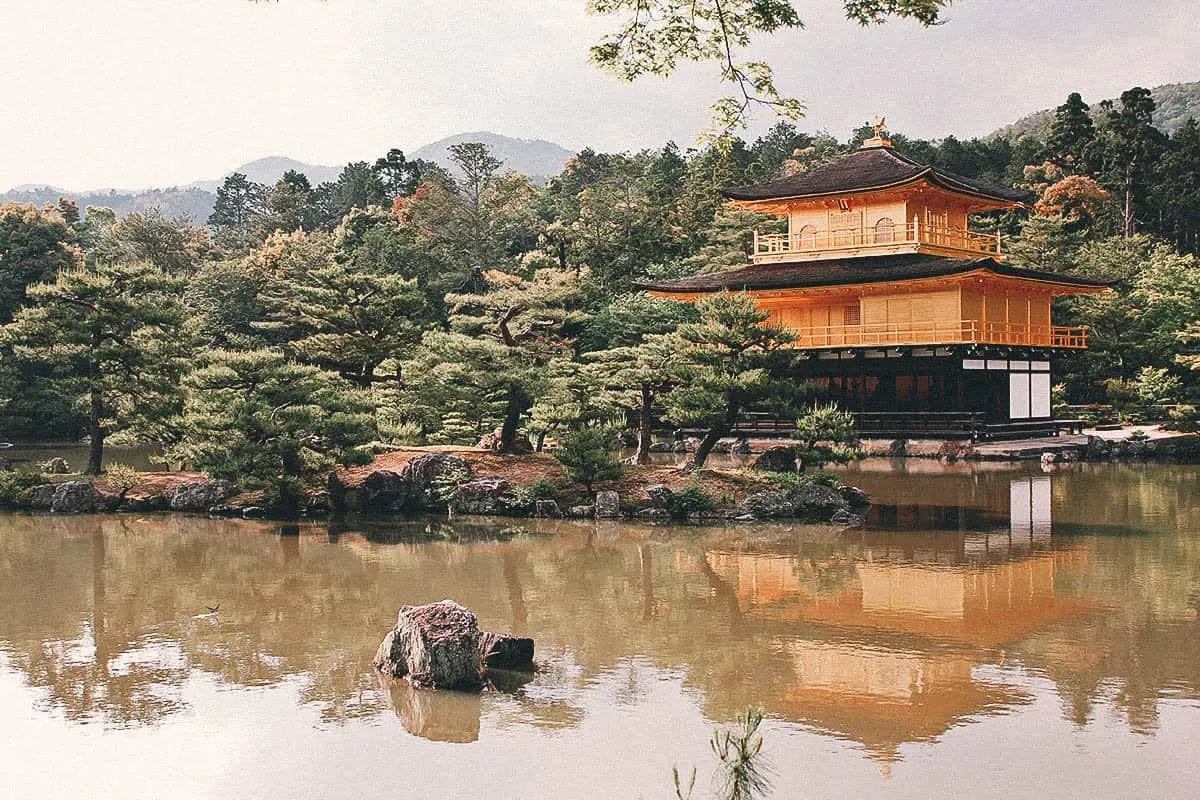
Suggested Length of Visit: About 1 hr
Admission: JPY 500
2. Fushimi Inari Shrine
Fushimi Inari Taisha is a Shinto shrine and one of Kyoto’s most recognizable landmarks. It’s known for it’s thousands of orange torii gates arching over a scenic, 2-3 hour-long hiking trail up sacred Mount Inari.
If you get hungry during your hike, then be sure to stop and enjoy a bowl of kitsune udon and some inari sushi. Both are local specialties associated with Fushimi Inari Shrine.
Check out my article on Fushimi Inari Taisha for more pictures and information. If you’d like to explore the shrine with a guide, then you can book a tour through Klook, Get Your Guide, or Magical Trip.
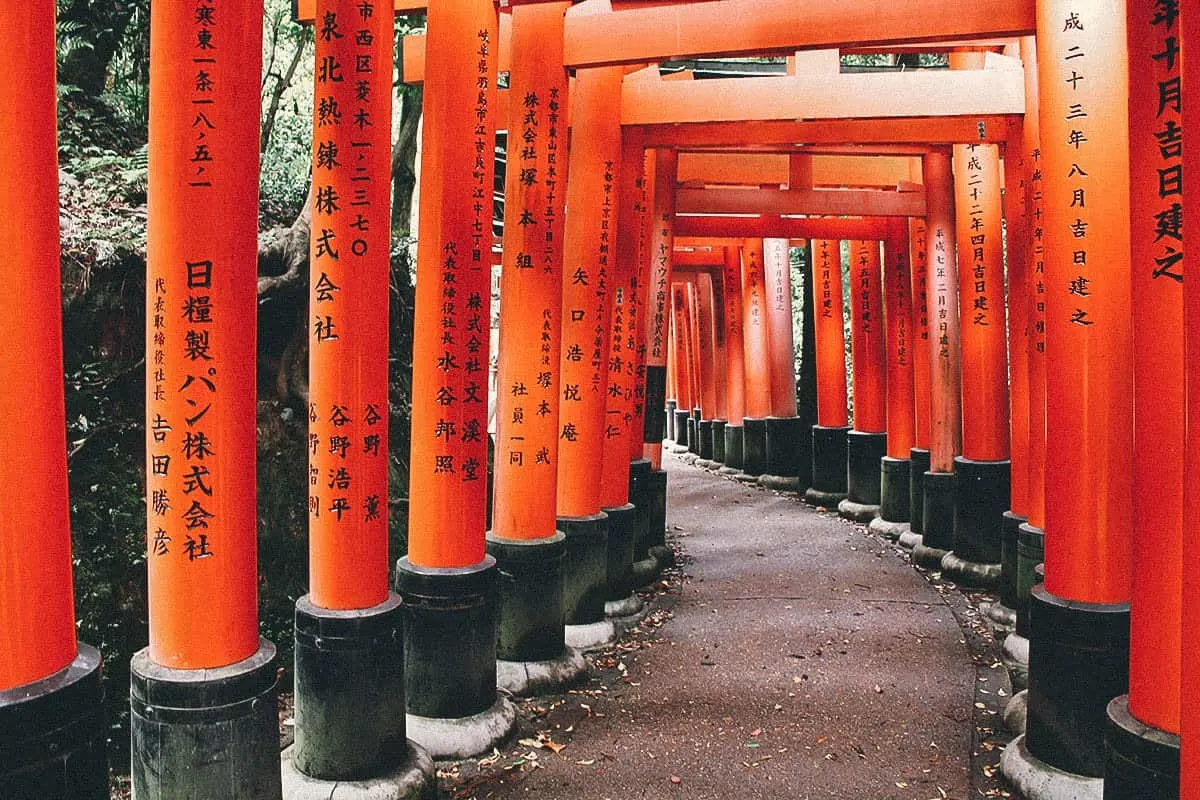
Suggested Length of Visit: About 2-3 hrs
Admission: FREE
3. Arashiyama Bamboo Groves
The Arashiyama District’s bamboo groves is one of the most popular and photographed areas in Kyoto. Famous for its towering stalks of bamboo, it’s a magical place that’s reminiscent of that iconic scene from Crouching Tiger, Hidden Dragon.
Apart from these bamboo groves, the entire Arashiyama area is dotted with picturesque temples, gardens, quaint shops, and restaurants. It’s a great place to spend the day wearing a kimono and taking pictures.
Check out my article on Arashiyama Bamboo Groves for more pictures and information. A hand-pulled rickshaw ride through the bamboo forest is a popular activity in Arashiyama. You can book a rickshaw ride and other Arashiyama tours on Klook, Get Your Guide, or Magical Trip.
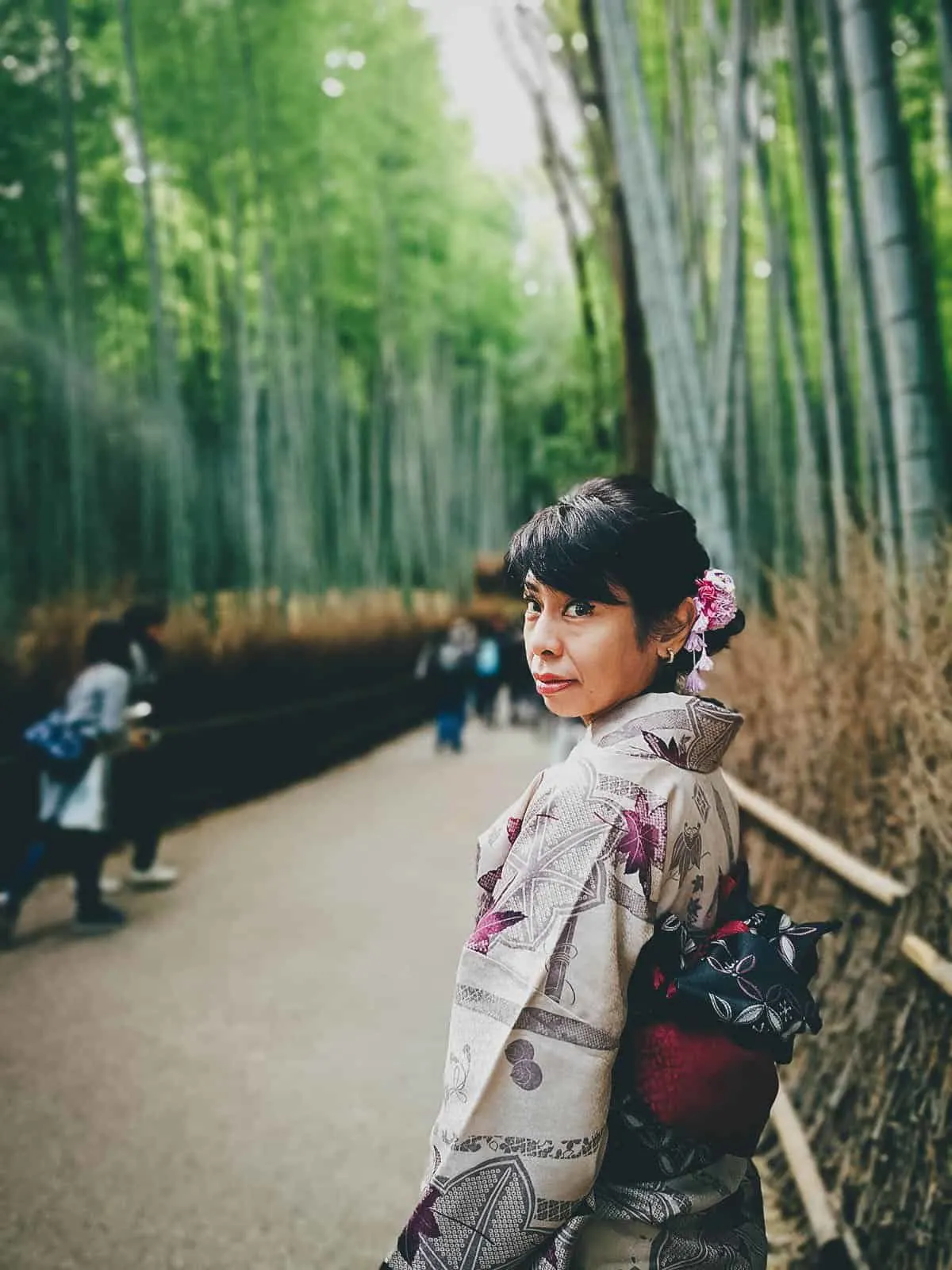
Suggested Length of Visit: At least half a day
Admission: FREE
4. Tenryu-ji
Tenryu-ji is a UNESCO World Heritage Site and considered the most important temple in Arashiyama. It’s located right next to the bamboo groves and is home to landscaped Japanese gardens featuring a central pond with the forested Arashiyama mountains as its backdrop.
We were at the temple in late November and as you can see below, the colors of autumn were on full display. It was incredibly beautiful and one of many reasons why Arashiyama is my favorite area in Kyoto.
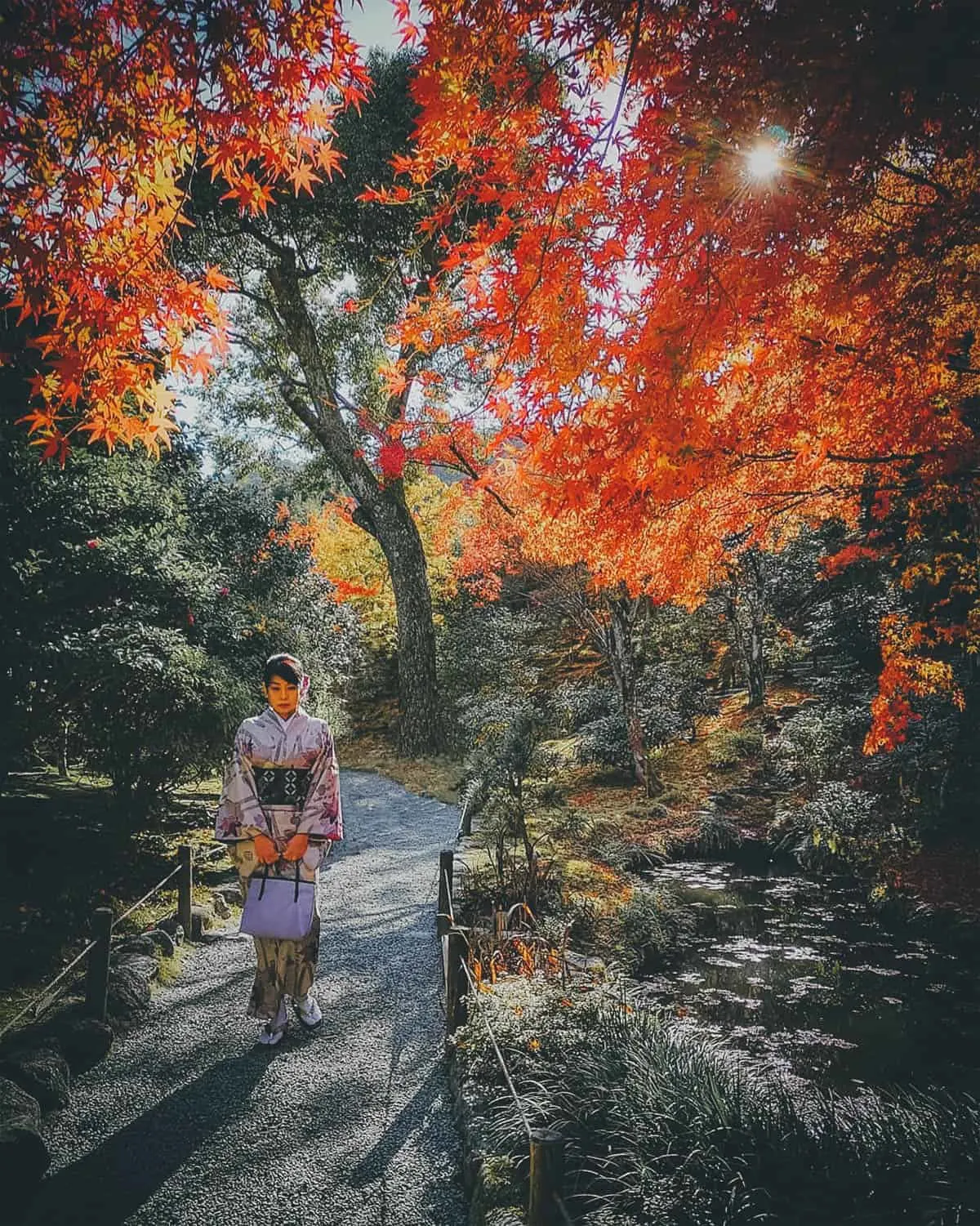
Suggested Length of Visit: About 1 hour
Admission: JPY 500
5. Ryoan-ji
Ryoan-ji is a picturesque Buddhist temple in a heavily wooded area east of Arashiyama. It features a large pond, well-maintained Japanese gardens, and the most famous rock garden in Japan.
As celebrated as it is, the history and meaning of Ryoan-ji’s rock garden is unclear. It features a rectangular plot of pebbles with fifteen rocks laid out on patches of moss that resemble islands.
It’s easy to visit Ryoan-ji on your own, but it may be nice to go on a guided tour with a local who can shed more light on the mysteries of its rock garden.
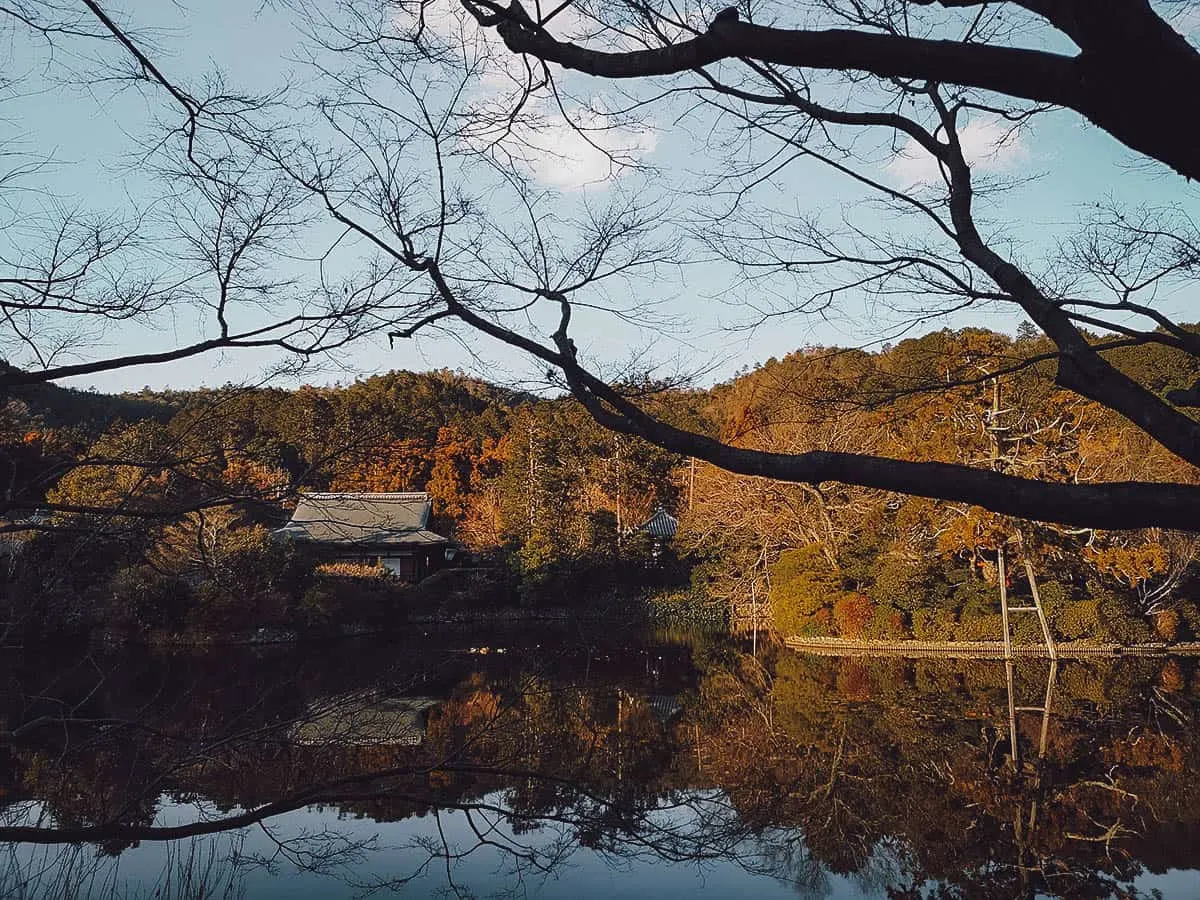
Suggested Length of Visit: About 1-2 hrs
Admission: JPY 500
6. Kiyomizu-dera
Kiyomizu-dera is a UNESCO World Heritage Site and one of the most famous temples in Kyoto. It’s known as a temple for making wishes and features a large wooden stage built without the use of a singe nail.
Meaning “Pure Water Temple”, Kiyomizu-dera is built on the site of the sacred Otowa Waterfall. It features three separate streams of water that visitors are free to drink from. It’s believed that drinking from these streams grant people’s wishes for longevity, success at school, and a prosperous love life.
Check out my article on Kiyomizu-dera for more pictures and information. It’s an interesting temple with plenty to see and do. If you’d like to go on a guided tour, then you can book one through Klook or Get Your Guide.
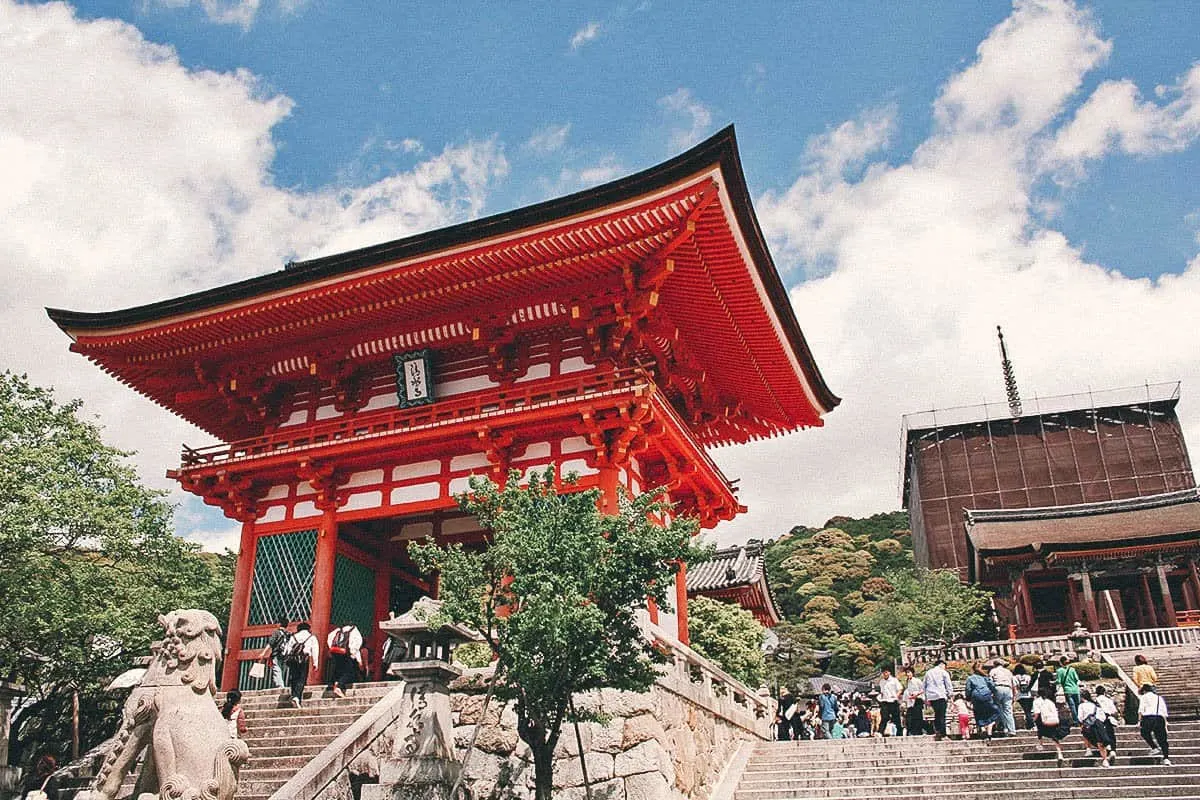
Before or after visiting Kiyomizu-dera, be sure to explore charming Sannen-zaka and Ninen-zaka streets. On both sides of these gently sloping roads are traditional wooden houses, many of which have been converted into shops, cafes, restaurants, and teahouses. It’s one of the most well-preserved and atmospheric areas in Kyoto.
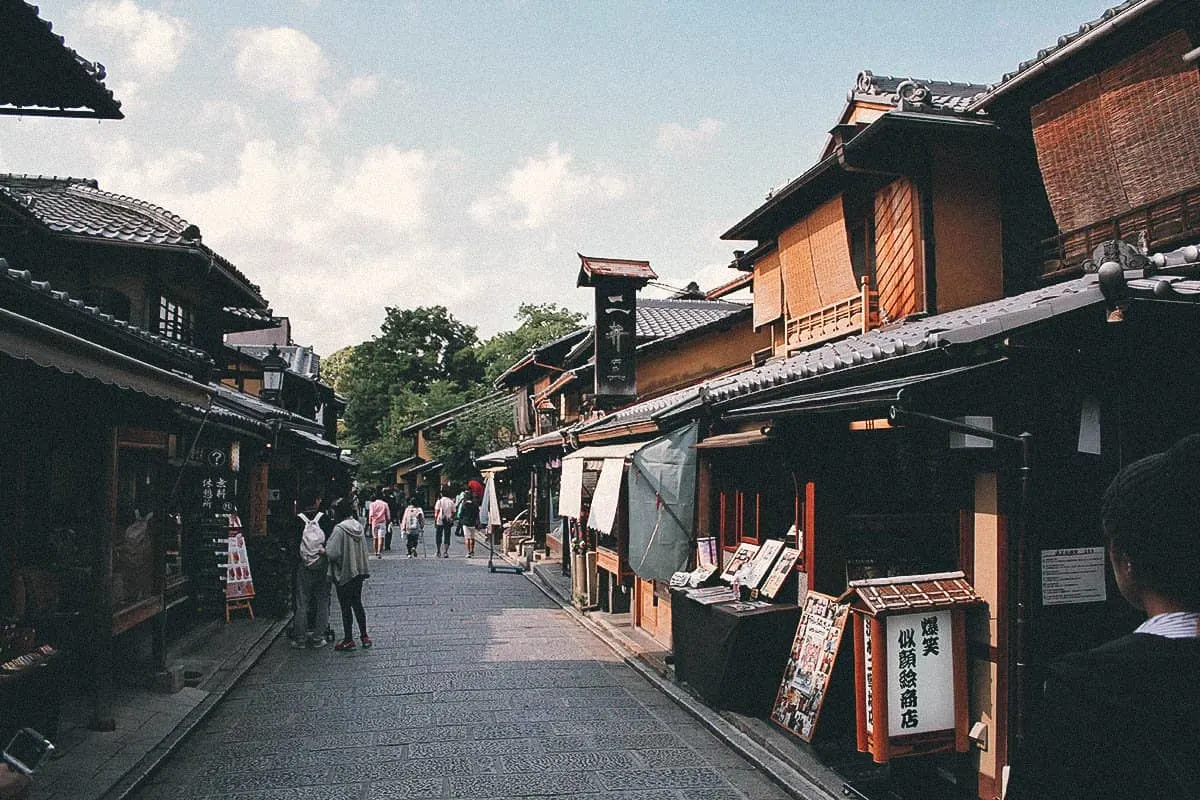
Suggested Length of Visit: About 2 hrs
Admission: JPY 400
7. Yasaka Shrine
Located just a few minutes from Kiyomizu-dera is Yasaka Shrine, one of Kyoto’s most famous Shinto shrines. It’s best known for its summer festival held every July called the Gion Matsuri.
The Gion Matsuri is arguably Japan’s most famous festival. It dates back over a thousand years and features massive floats measuring up to 25 meters (82 ft) in height.
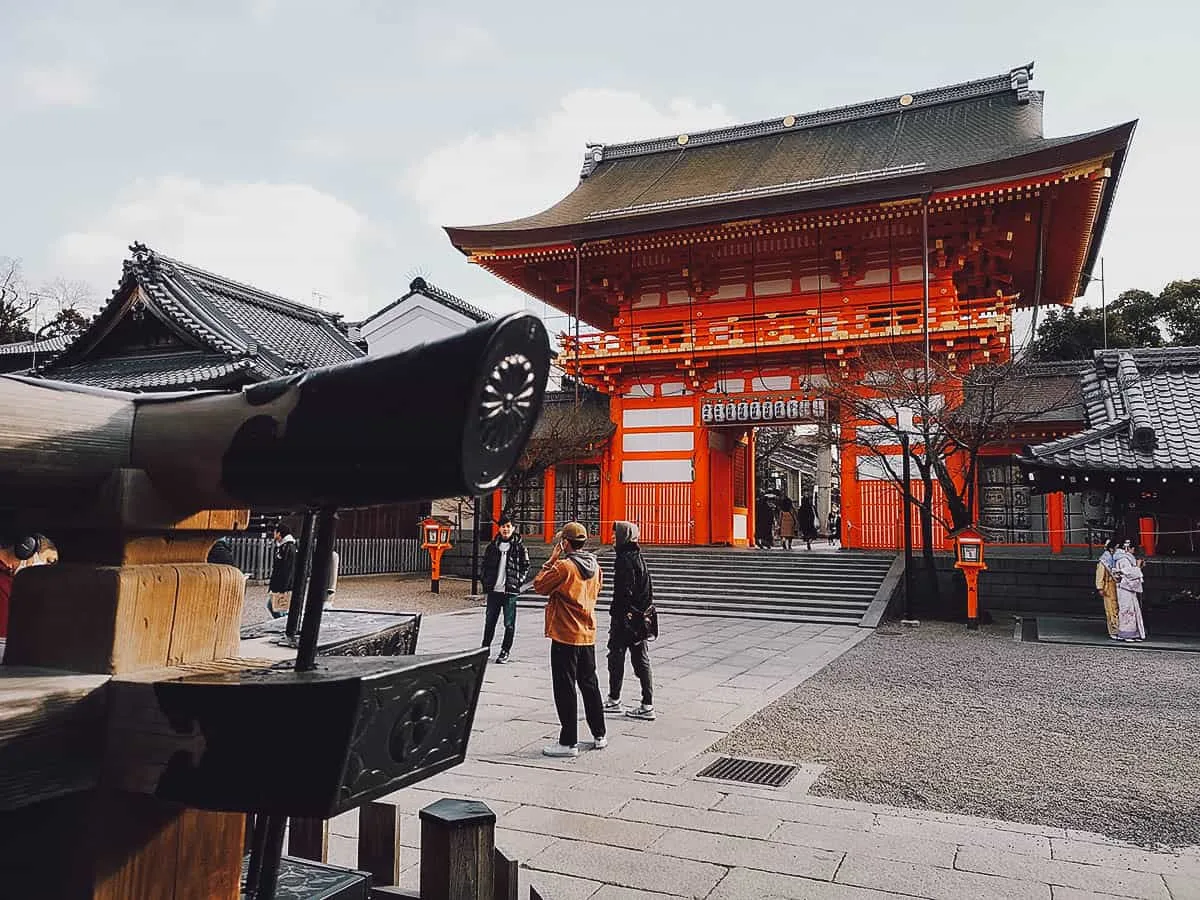
If you’re traveling to Kyoto in late March or early April, then you may want to check out Maruyama Park. Located right next to Yasaka Shrine, it’s a public park with dozens of cherry trees. It’s one of the most popular spots in Kyoto to view the cherry blossoms during the first half of April.
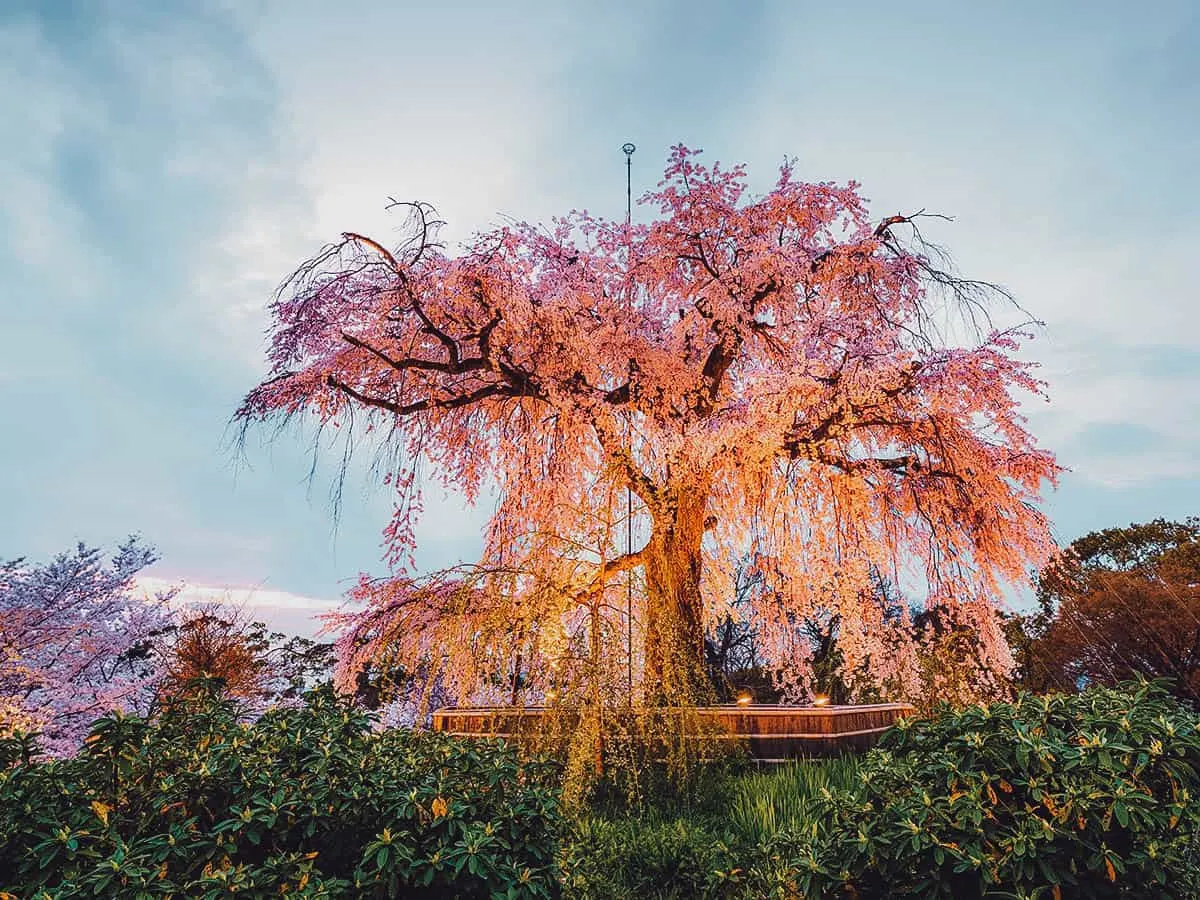
Photo by Sean Pavone via Shutterstock
Suggested Length of Visit: About 1 hr
Admission: FREE
8. Nijo Castle
Nijo Castle is a UNESCO World Heritage Site and the former castle residence of Tokugawa Ieyasu, Japan’s first Edo Period shogun. It’s famous for its landscaped gardens, cherry trees, and an ingenious alarm system known as the nightingale floors.
With every step, flooring nails beneath the floorboards rub against a jacket or clamp to produce low creaks reminiscent of chirping sounds, hence the name “nightingale floors”. It was a warning system designed to alert the shogun and his bodyguards of any impending ninja attacks.
Check out my article on Nijo Castle in Kyoto for more pictures and information. You can purchase admission tickets at the gate or in advance through Klook. If you’d like to explore the castle with a guide, then you can book a tour through Get Your Guide.
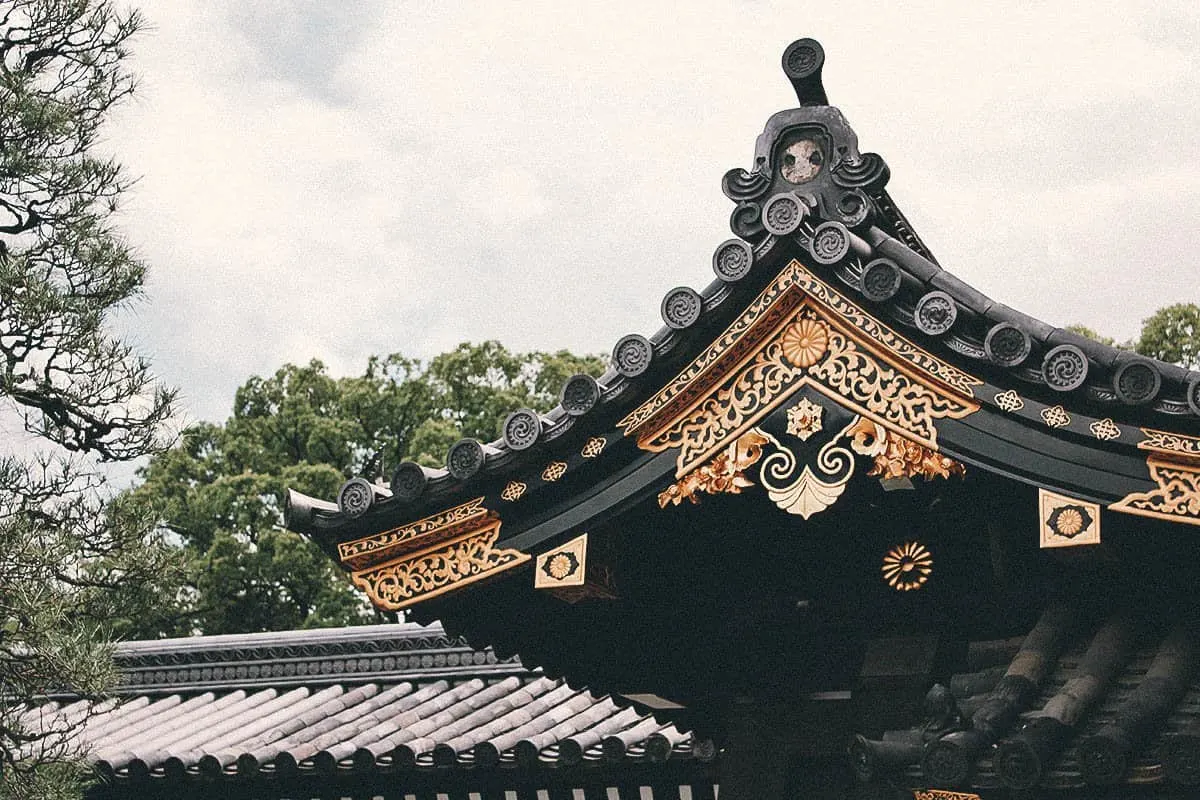
Suggested Length of Visit: About 1-2 hrs
Admission: JPY 800
9. Ginkaku-ji
Ginkaku-ji or the Silver Pavilion is a Zen Buddhist temple that was patterned after the similarly named Kinkaku-ji. It was the retirement villa of the grandson of Kinkaku-ji’s former owner, hence the similarities.
In spite of its name, Ginkaku-ji isn’t covered in silver. It’s a beautiful temple nonetheless that’s one of the stops on the Philosopher’s Path – a stone path along a canal lined with hundreds of cherry trees.
If you’d like to explore Ginkaku-ji and the Philosopher’s Path with a guide, then you can book a tour through Get Your Guide.
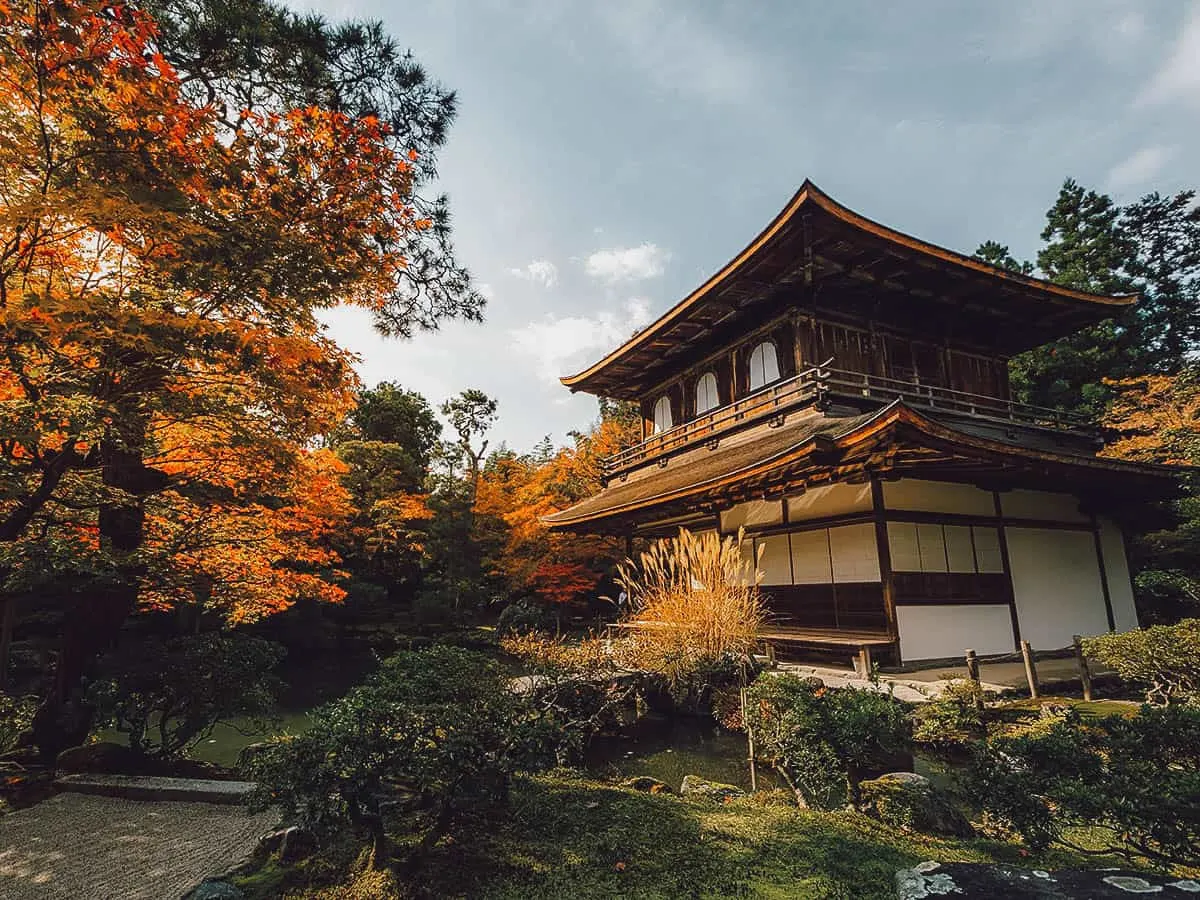
Photo by vichie81 via Shutterstock
Suggested Length of Visit: About 1-2 hrs
Admission: JPY 500
10. Kyoto Tower
Kyoto Tower is the tallest structure in the city. Its observation deck is perched 100 meters (328 ft) above the ground and offers 360° views of downtown Kyoto.
The tower is located just across the street from Kyoto station so you can make a quick trip to the top on your way in or out of the city. You can purchase entry tickets at the gate or in advance through Klook.
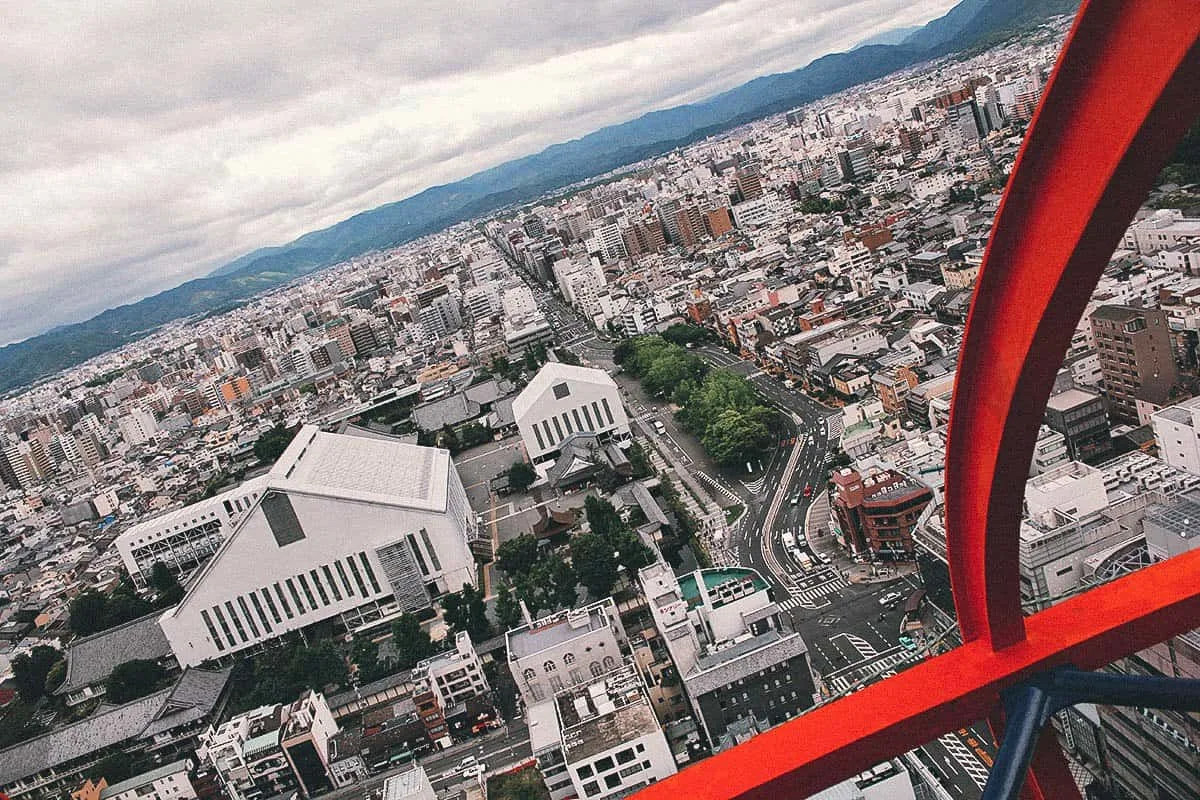
Suggested Length of Visit: About 1 hr
Admission: JPY 800
THINGS TO DO IN KYOTO
1. Rent a Kimono
I know that renting a kimono in Japan sounds touristy and cliched, but who cares? It’s fun and makes for great Instagram photos. Plus, there’s no better backdrop for it than Kyoto, the country’s center for culture and the arts.
There are kimono rental shops throughout the city. We were lucky to rent one on the spot in Arashiyama but according to my Japanese friend, they often run out during busy periods like cherry blossom season.
To be safe, you may want to reserve one in advance through Klook or Get Your Guide (Option 1 | Option 2). Just be sure to check the address of the rental shop to make sure its location is convenient for you.
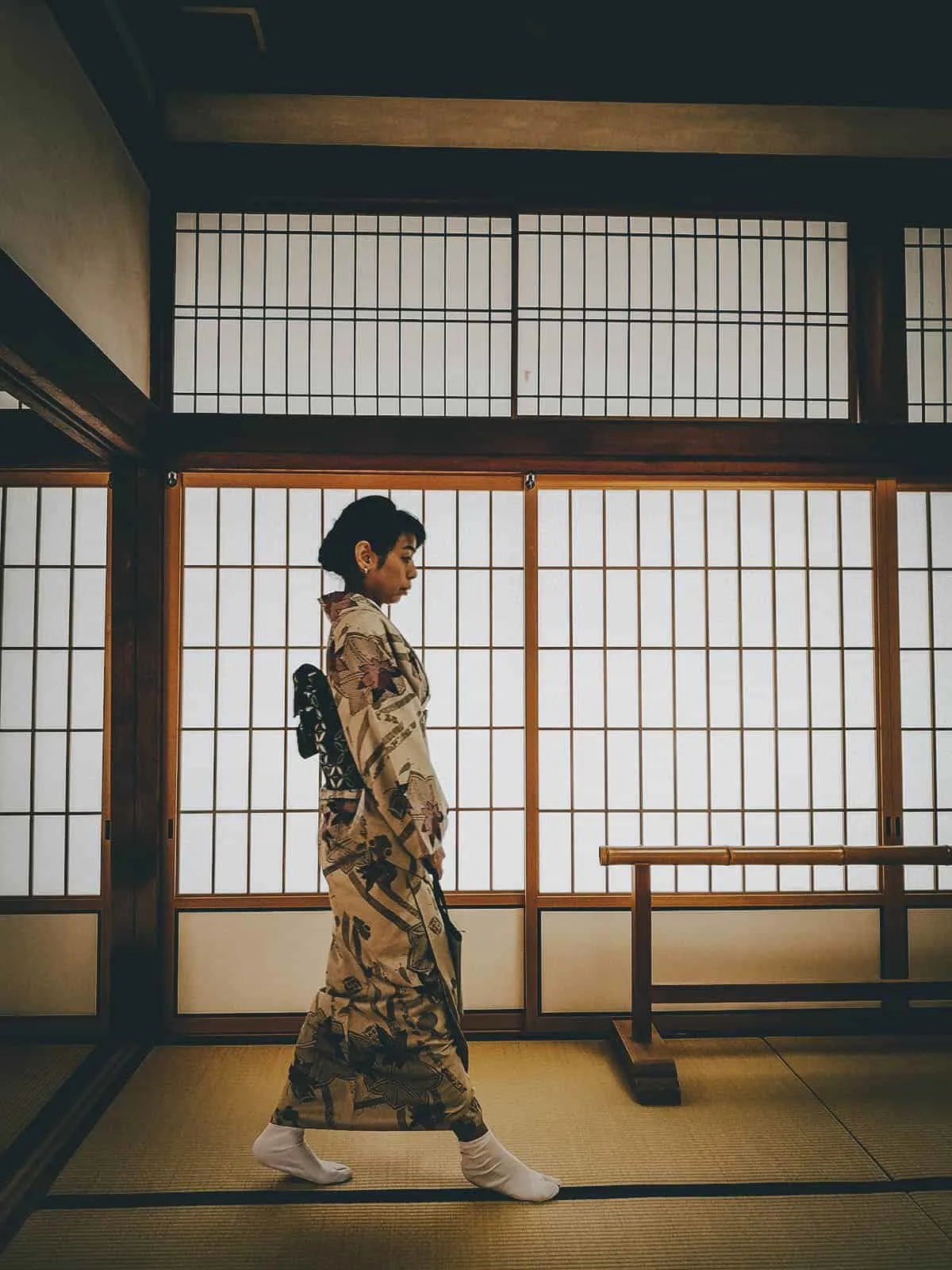
2. Eat Your Way Through Nishiki Market
Nicknamed “Kyoto’s Kitchen”, Nishiki Market is a long and narrow shopping street with over a hundred food shops and restaurants. It’s similar to Kuromon Ichiba Market in Osaka, which appropriately, is nicknamed “Osaka’s Kitchen”.
If you’d like to sample Kyoto’s myriad local delicacies, then you need to pay a visit to Nishiki Market. It’s about a 5-minute walk from Shijo subway station. You can also book a guided Nishiki Market food tour through Get Your Guide, byFood, or Magical Trip.
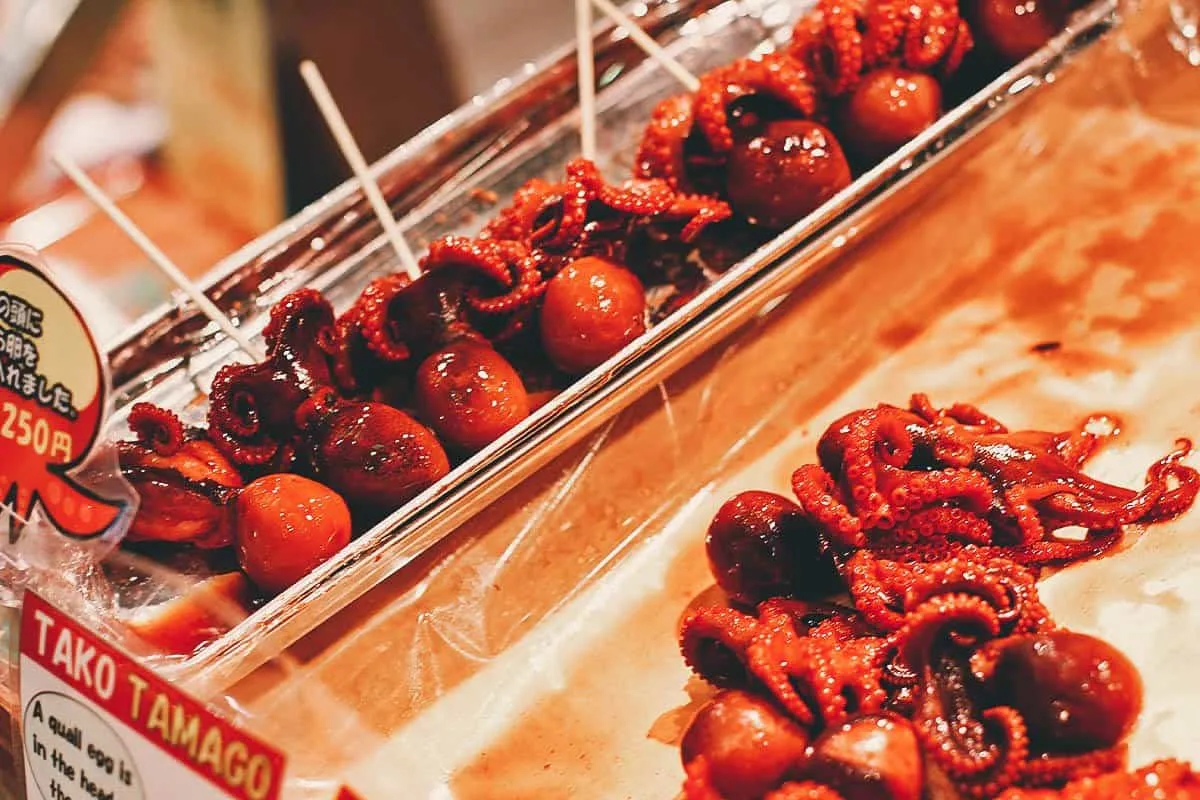
3. Explore a Geisha District
Exploring a geisha district is one of my favorite things to do in Kyoto. They’re atmospheric neighborhoods characterized by a network of wooden machiya shophouses. If you’re lucky, then you may even spot a geiko (geisha in the Kyoto dialect) and maiko (geisha apprentice) walking between teahouses.
There are five geisha districts in Kyoto but the legendary Gion District is the most famous with the highest number of active geikos. The area is actually comprised of two geisha districts – Gion Kobu and Gion Higahsi. Gion Kobu is the larger of the two and encompasses most of the district.
If you’re into street photography, then the Gion District is where you’ll want to be. It’s also a great place to rent a kimono for Instagram pictures. I explored Gion on my own but you can also go on a guided tour (Klook | Get Your Guide).
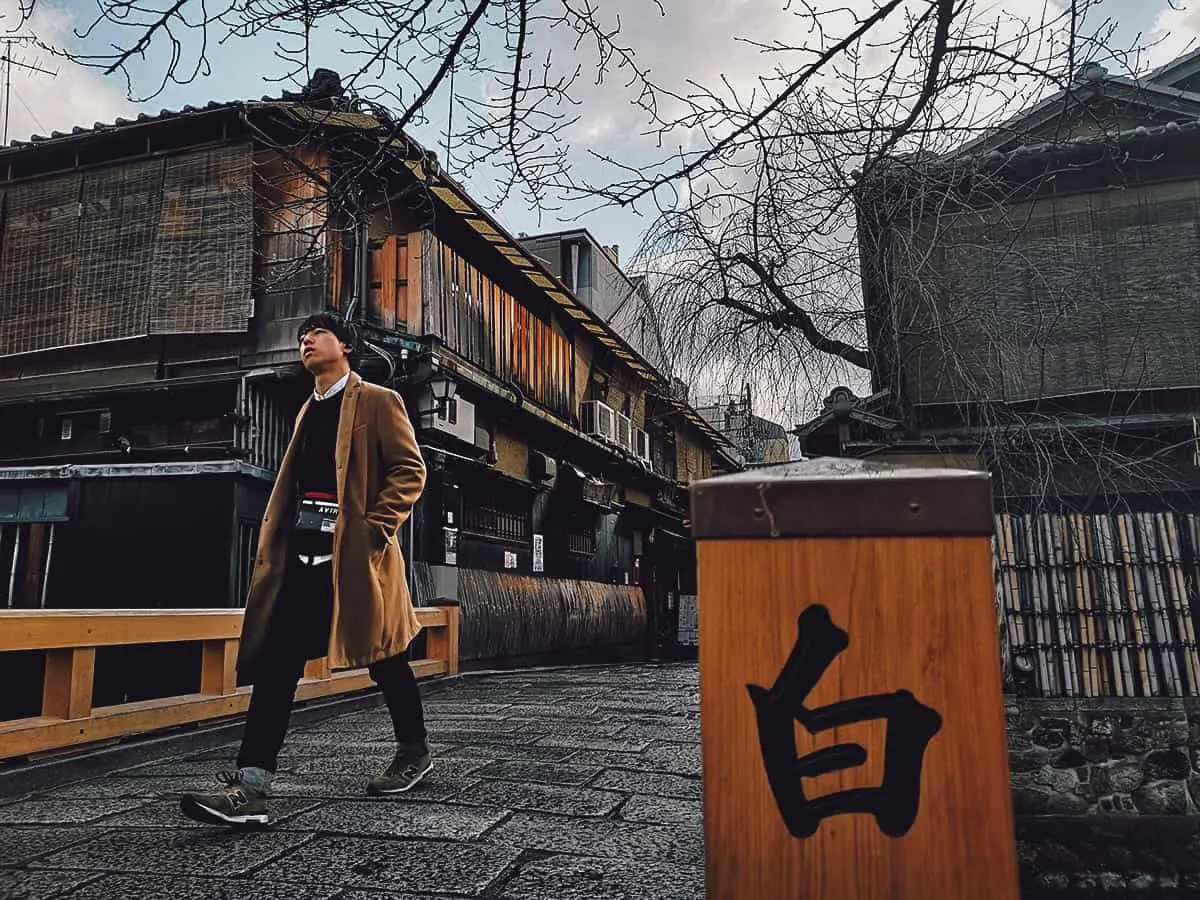
Another geisha district you can visit is Pontocho Alley. It’s a strip of restaurants and izakayas that runs parallel to the Kamo River on the opposite side of the Gion District. It’s much smaller than Gion but just as interesting.
Pontocho Alley is lovely at any time of the day but it’s best experienced at night. If you’d like to have a guide take you to its best spots, then you can book a food or bar hopping tour through Get Your Guide, byFood, or Magical Trip.
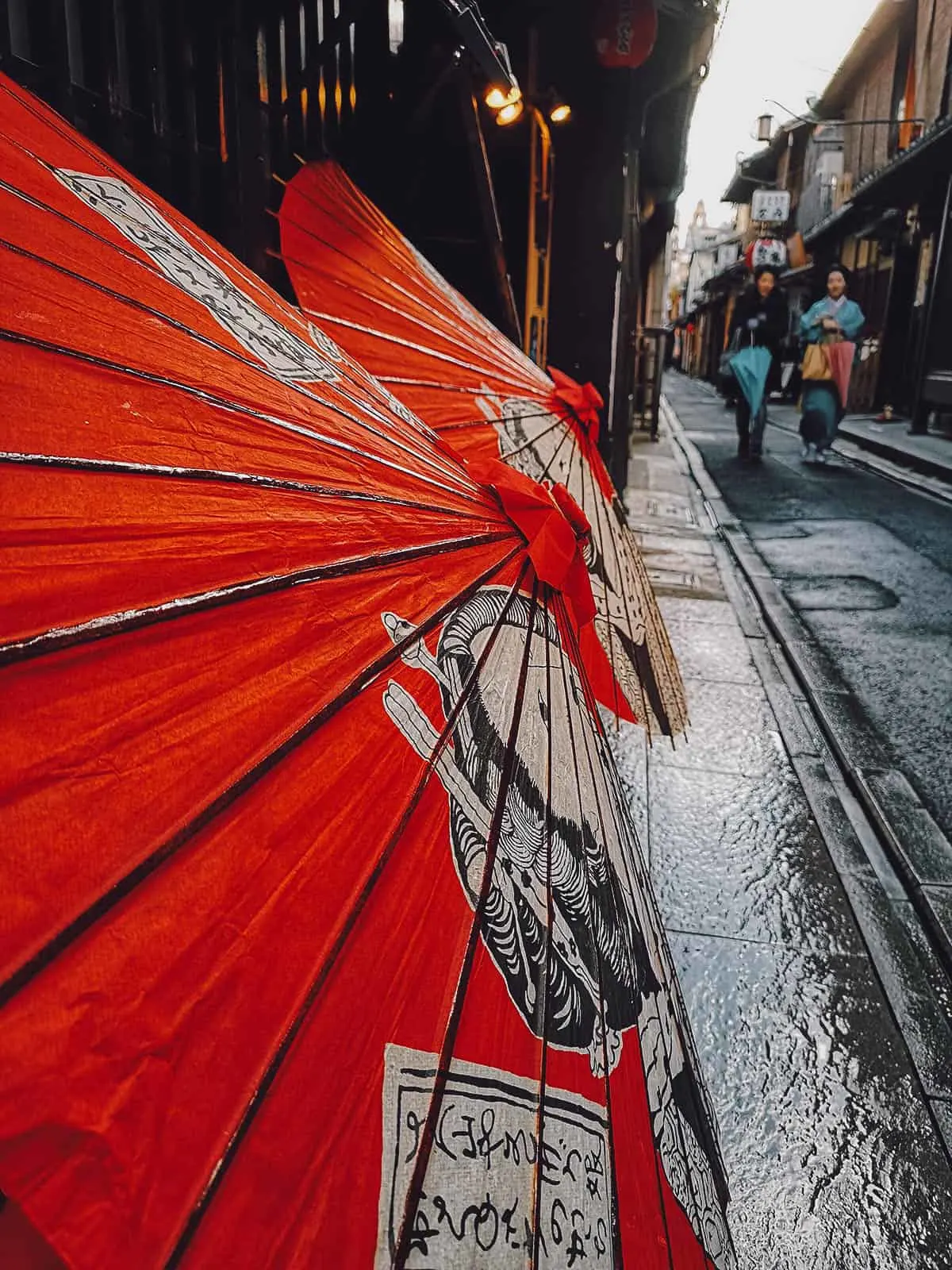
If you’ll be in Kyoto for sakura season, then you may be interested in catching the Miyako Odori. It’s a geiko and maiko performance held at Gion Kobu’s Kaburen-jo Theater near Yasaka Shrine.
Miyako Odori is considered one of the four great geisha spring shows in Kyoto. If you’d like to see it, then you’re advised to book your tickets well in advance. You can check the Miyako Odori website for more information.
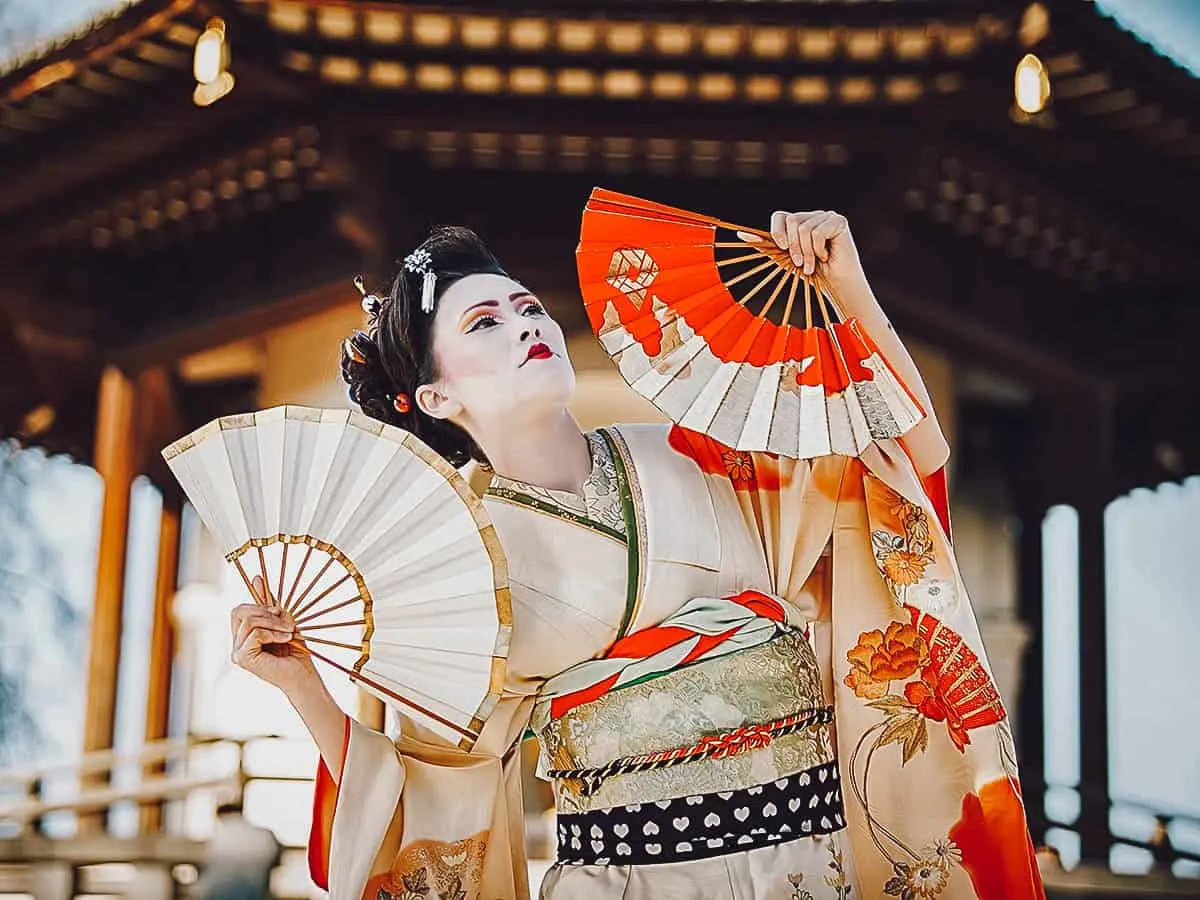
Photo by Pavel Rumme via Shutterstock
4. Enjoy a Tea Ceremony
Tea has been a part of Japanese culture for over a millennia but it wasn’t until the 16th century that it developed into the highly ritualized art form that it is today. Enjoyed by the nobility, it became defined by a set of rules and etiquette that went beyond the simple act of drinking tea.
Tea ceremonies can be enjoyed throughout Japan but none better perhaps than in Kyoto where the custom originated from. Kyoto remains the heart of Japan’s tea culture and is the ideal place for foreigners to experience a formal tea ceremony.
I’ve only experienced informal tea ceremonies which are much more relaxed. As rigid as they sound, I’d love to try the real thing on our next trip to Japan. You can book a tea ceremony experience in Kyoto through Klook, Get Your Guide, Magical Trip, or byFood.
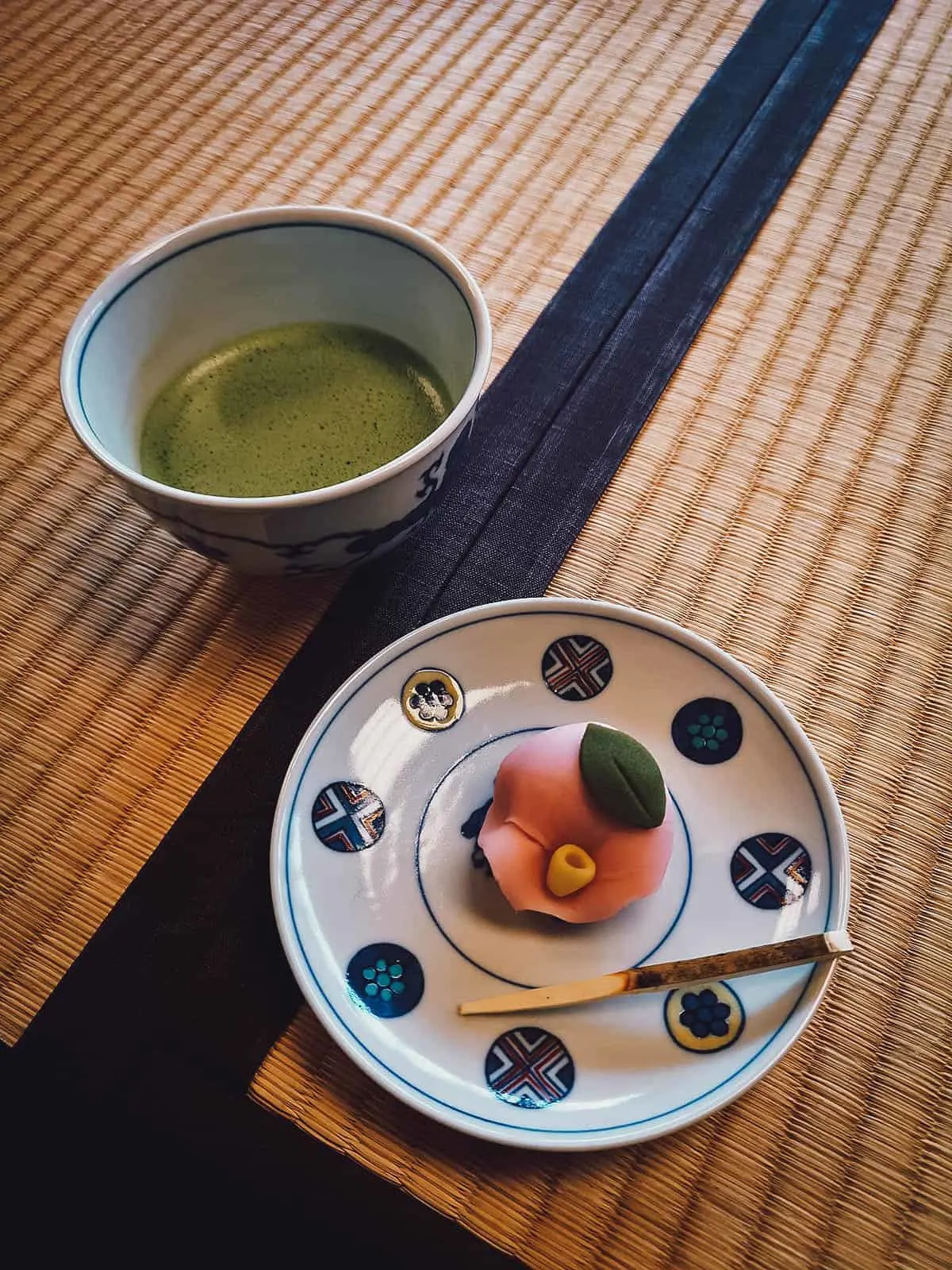
5. Go Sake Tasting in Fushimi District
If you like sake, then you need to visit the Fushimi Sake District. It’s a traditional sake brewing district along the Horikawa River in southern Kyoto. It’s home to nearly forty breweries and is the second largest sake district in Japan, behind only Nada in Kobe.
I went on a sake tasting tour in Fushimi District that really turned me on to sake. Seeing how it’s made and learning to pair it with the right food gave me a much better appreciation for it.
There are a few breweries and museums you can visit but if you’d like to really learn about sake, then I highly recommend going on a sake tasting tour. You can book one through Klook, Get Your Guide, byFood, or Magical Trip.
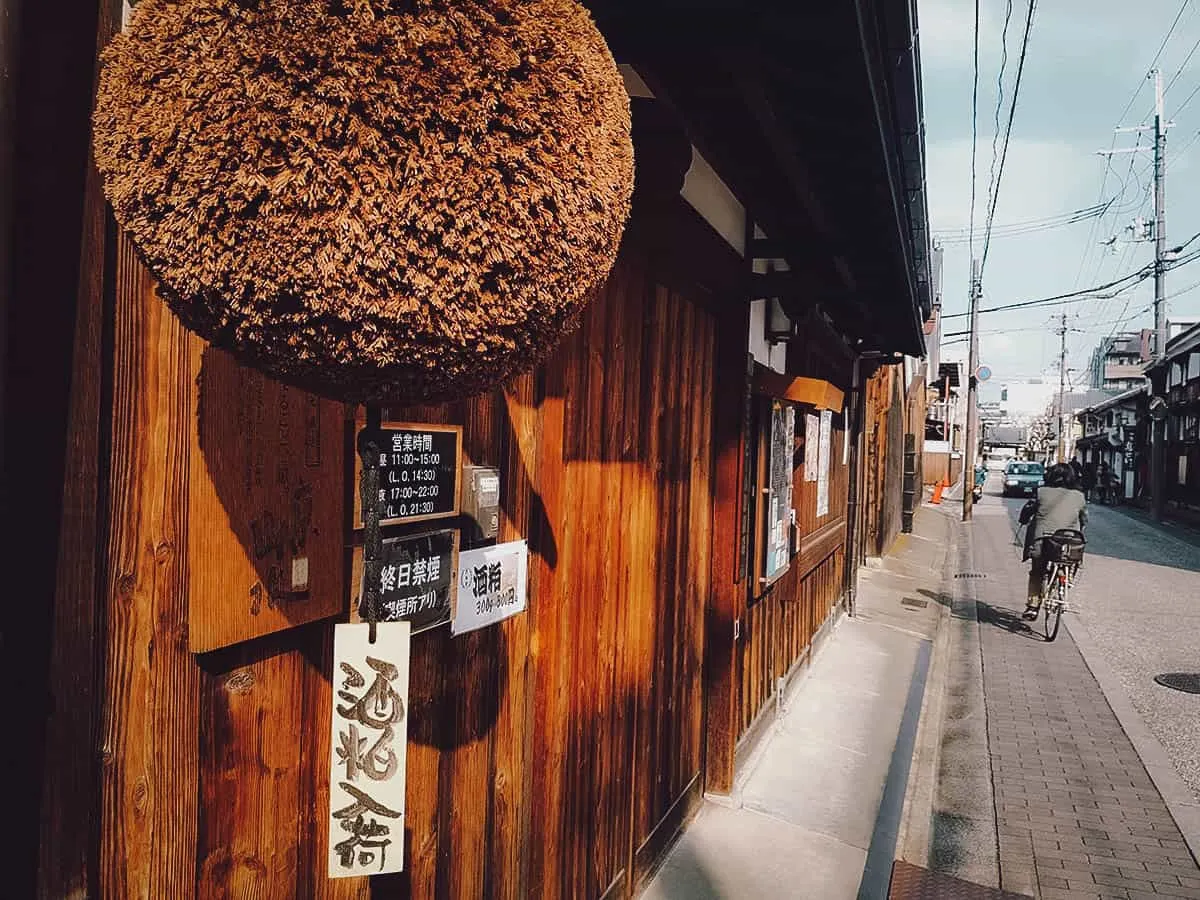
Sake is nice on its own but learning to pair it with the right food makes all the difference.
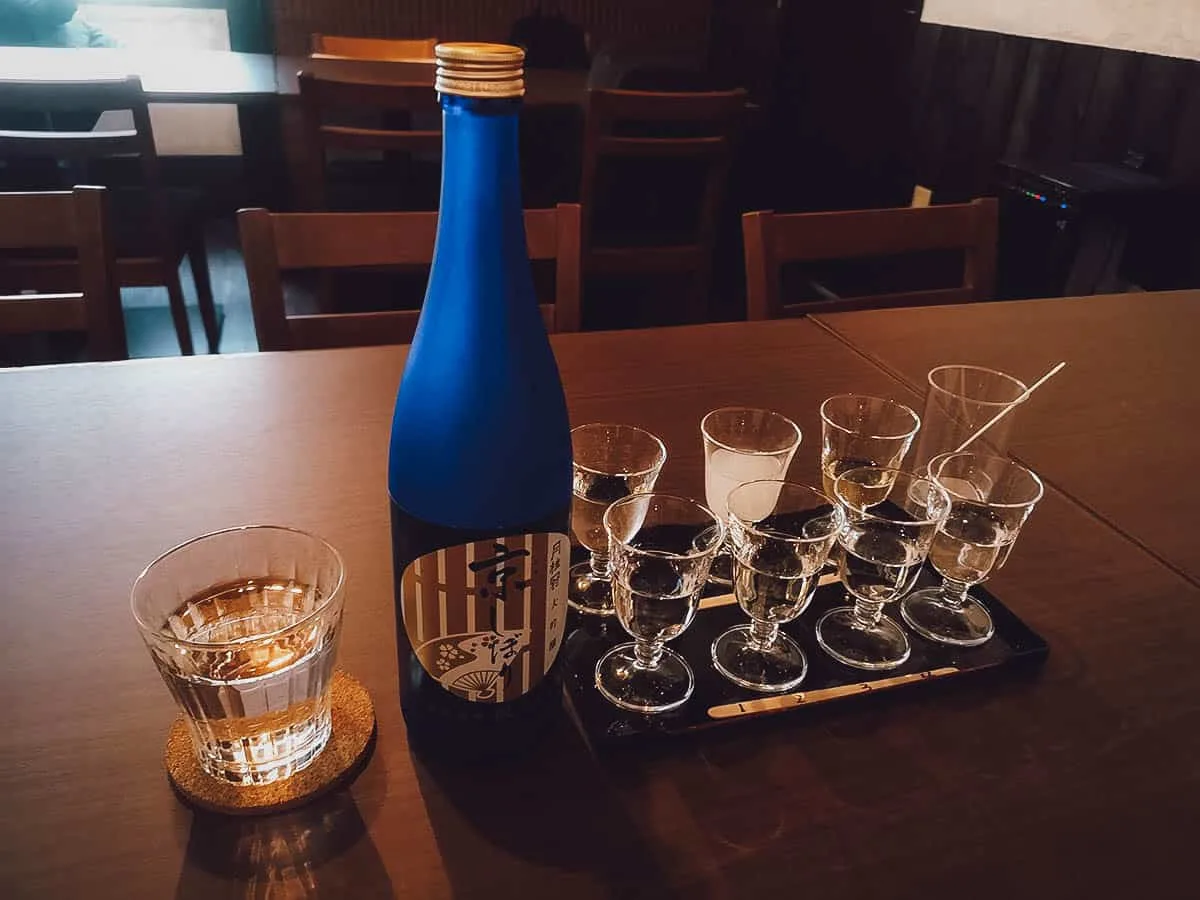
6. Ride the Sagano Romantic Train
The Sagano Romantic Train is a sightseeing train that runs along the Hozugawa River between Arashiyama and Kameoka. It features vintage trains with wooden benches that wind their way slowly through western Kyoto, offering tourists a spectacular view of the river and mountain scenery.
The train ride is lovely at any time of the year but especially in the spring and fall when the landscape bursts with color. It’s extremely popular during that time so you’re advised to reserve tickets in advance. You can book tickets to the Sagano Romantic Train on Klook.
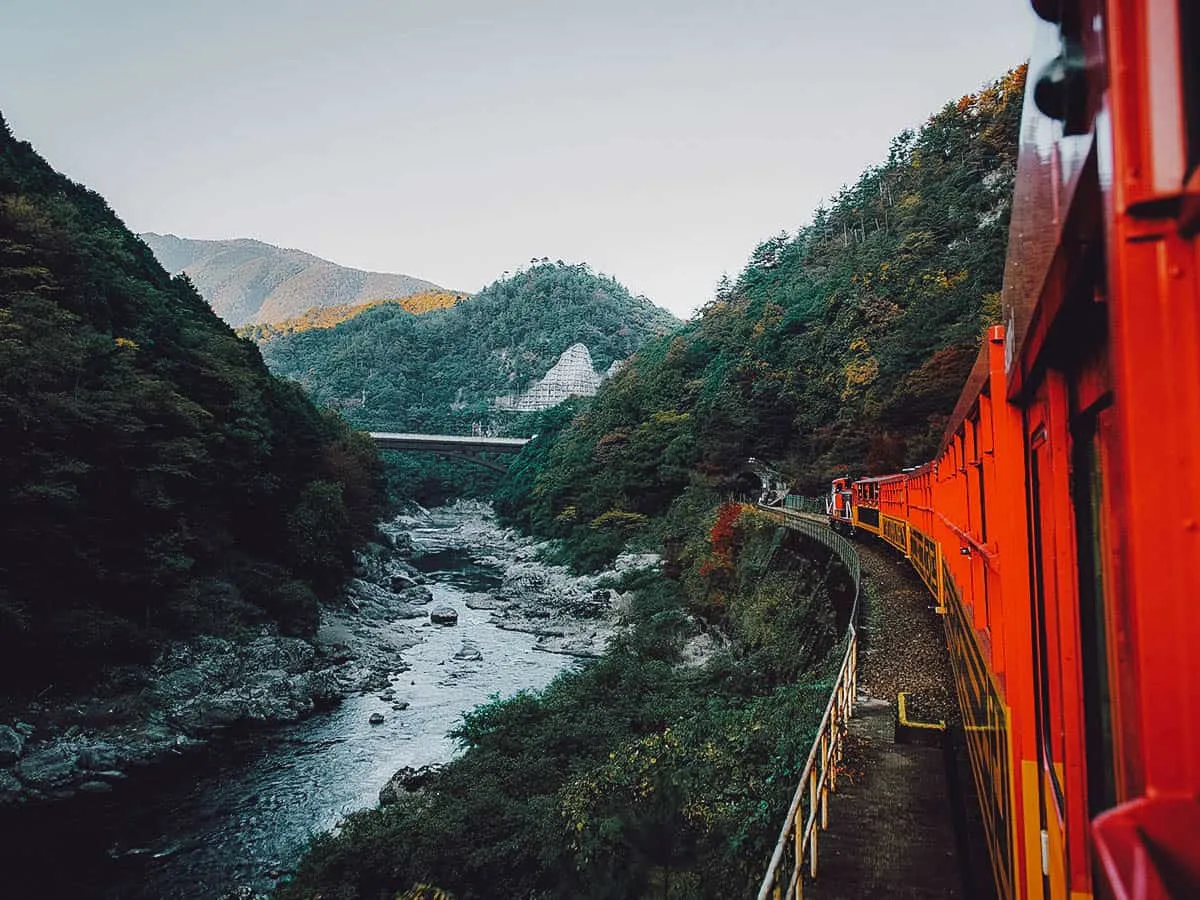
Photo by Somjade Srimahachota via Shutterstock
7. Play Samurais and Ninjas at Toei Kyoto Studio Park
Toei Uzumasa Eigamura is an active movie studio and theme park in western Kyoto. It features a recreated Edo period town that’s used as a backdrop for period films and television dramas.
Park attendants are dressed in historical costumes so it really does feel like you’ve been transported to Edo-period Kyoto. When we were there in 2014, they were shooting scenes for a movie or TV show. It’s an active studio where an estimated 200 period films are shot every year.
Aside from the movie sets, the studio park also features samurai- and ninja-themed attractions like mystery houses and mazes, even a haunted house. It makes for a fun couple of hours if you’re traveling with kids or have a fondness for samurais and ninjas. There’s an anime museum there as well.
Check out my article on Toei Kyoto Studio Park for more pictures and information.
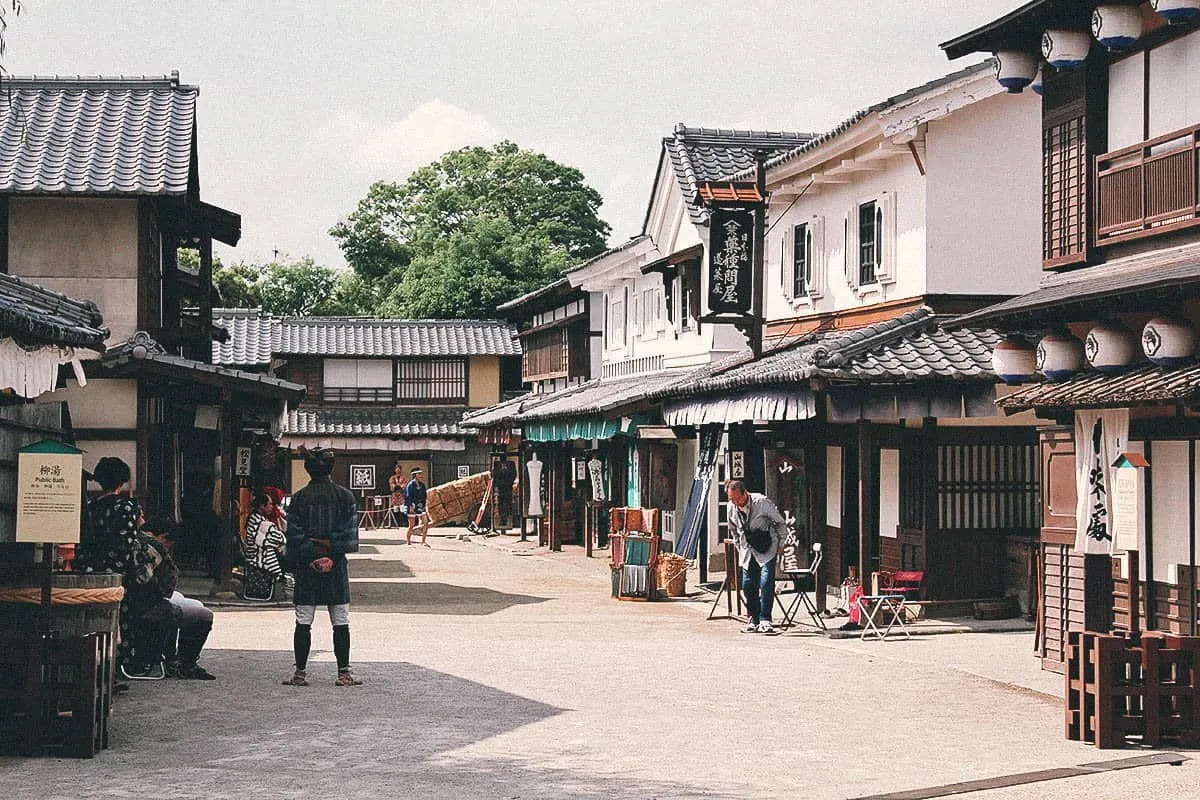
Suggested Length of Visit: 2-3 hrs
Admission: JPY 2,400 (adults), JPY 1,200 (children)
8. Explore Kyoto with a Local
It goes without saying that local knowledge is key to having authentic experiences, especially when it comes to food. Some of the best food experiences we’ve had on our travels often come from local recommendations – either from a friend or tour guide, even from a Grab or Uber driver.
If you want to have a Kyoto experience that goes beyond the usual temples and shrines, then I suggest checking out byFood and Magical Trip. They’re both fun Japanese boutique tour companies that offer small group experiences led by locals.
We’ve been on two Magical Trip tours so far – a Shinjuku food tour in Tokyo and a food tour in Kyoto’s Gion district. Both were excellent. You can click on the links for more pictures and information.
Visitors to Kyoto can book the same Gion food tour or check out this bar hopping tour in Pontocho Alley. There’s a lot of interesting food to be discovered in Gion so it really helps to go with a knowledgeable local.
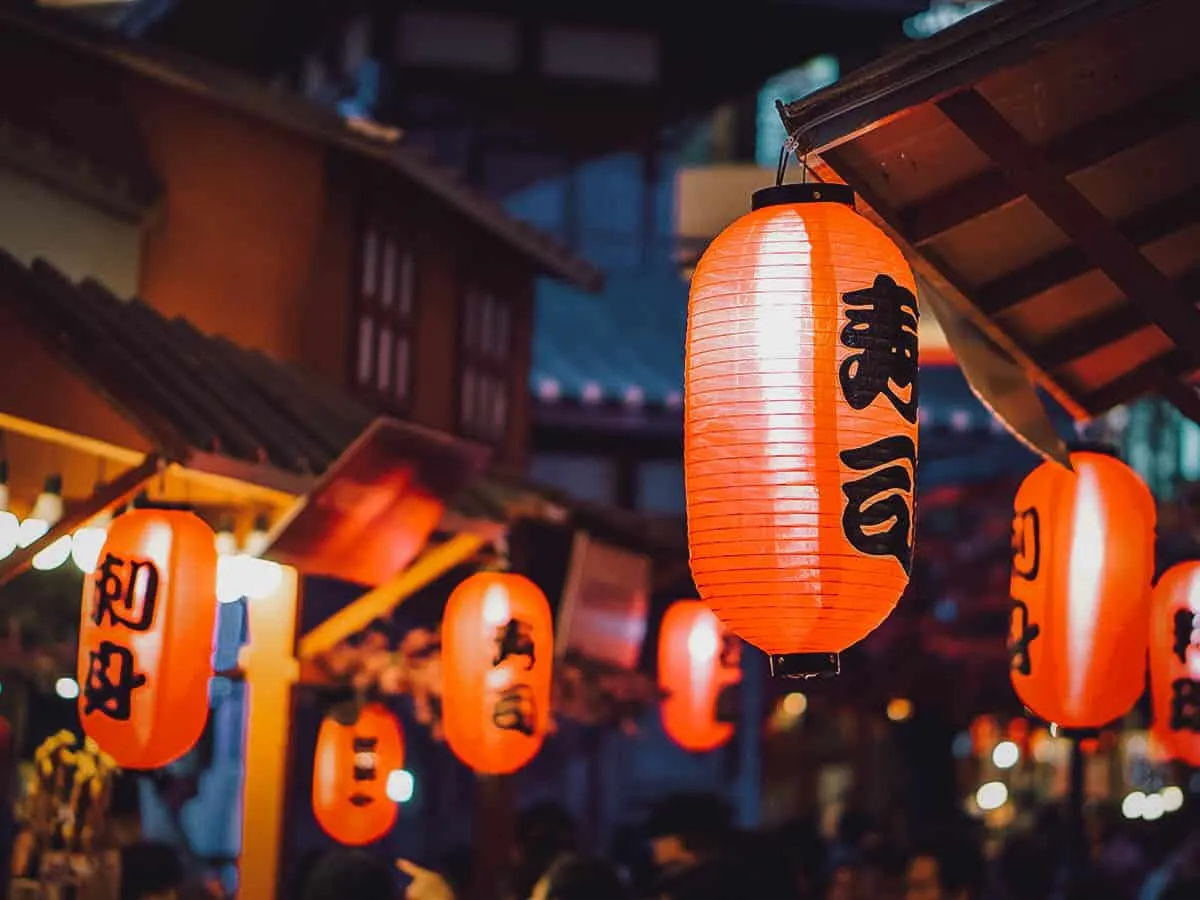
Photo by Benze Ponsak via Shutterstock
9. Take a Cooking Class
We enjoy taking cooking classes when we travel. So far, we’ve taken classes in Hoi An, Phuket, Chiang Mai, Bali, and Tokyo. Simply put, there’s no better way to learn about local food than by taking a cooking class.
If you’re interested in taking a cooking class in Kyoto, then I suggest searching for one on airKitchen or byFood.
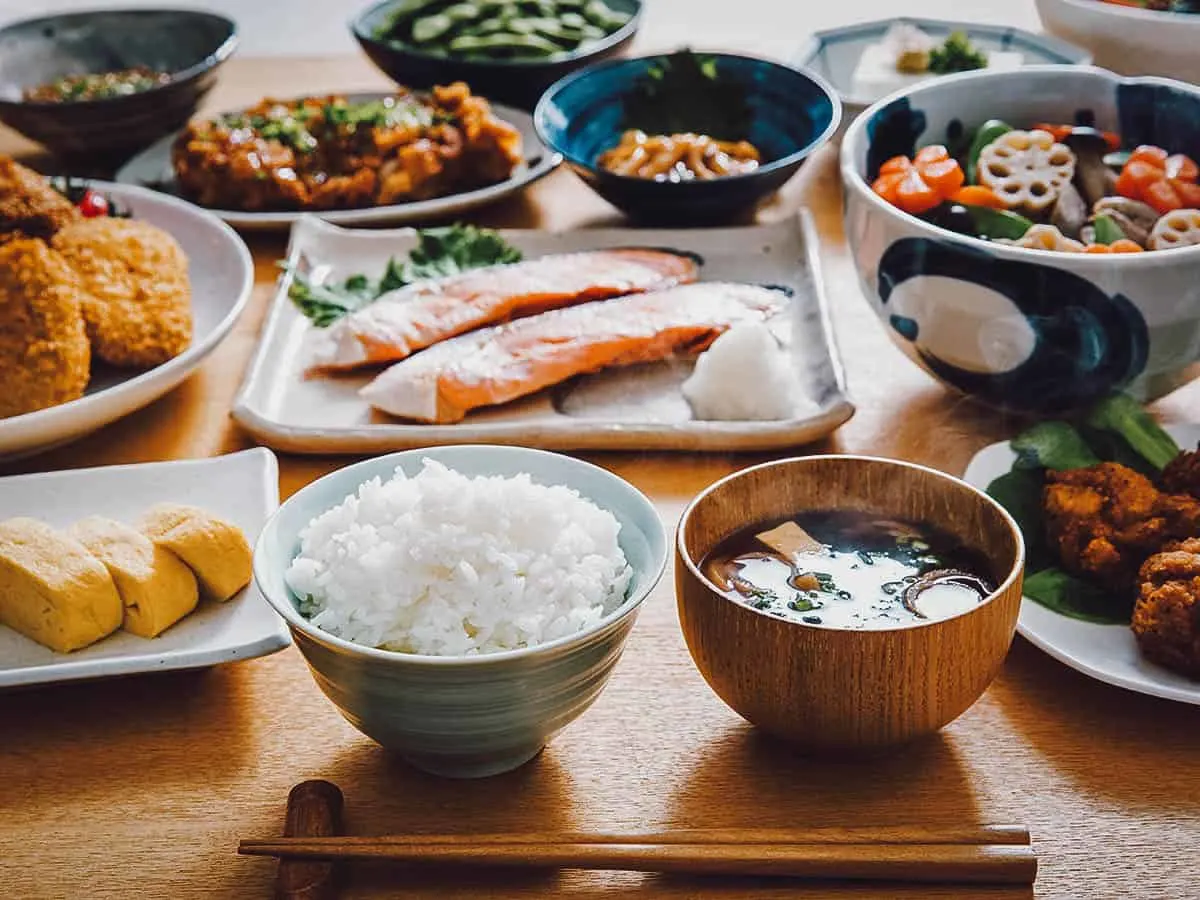
Photo by kazoka via Shutterstock
DAY TRIPS FROM KYOTO
If you’re spending enough time in Kyoto, then you may want to go and explore beyond the city. Listed below are five of the most popular and interesting day trips you can make from Kyoto. Be sure to check out our article on day trips from Kyoto for more recommendations.
1. Kifune Shrine
Kifune Shrine is located just beyond the city in northern Kyoto but it’s far enough away to list as a day trip. It’s in Kibune, a small town that was built around the shrine.
Kifune Shrine is dedicated to the god of water and rain and is believed to be the protector of those traveling by sea. It’s a popular summer retreat though it’s perhaps best visited in autumn when the surrounding forest explodes with color.
The shrine is well-known for its stone steps with red lanterns on either side. There are a few ryokans and restaurants in Kibune and a hiking trail that takes you to Kurama-dera temple and Kurama Onsen which is believed to be one of the best hot springs in Kyoto.
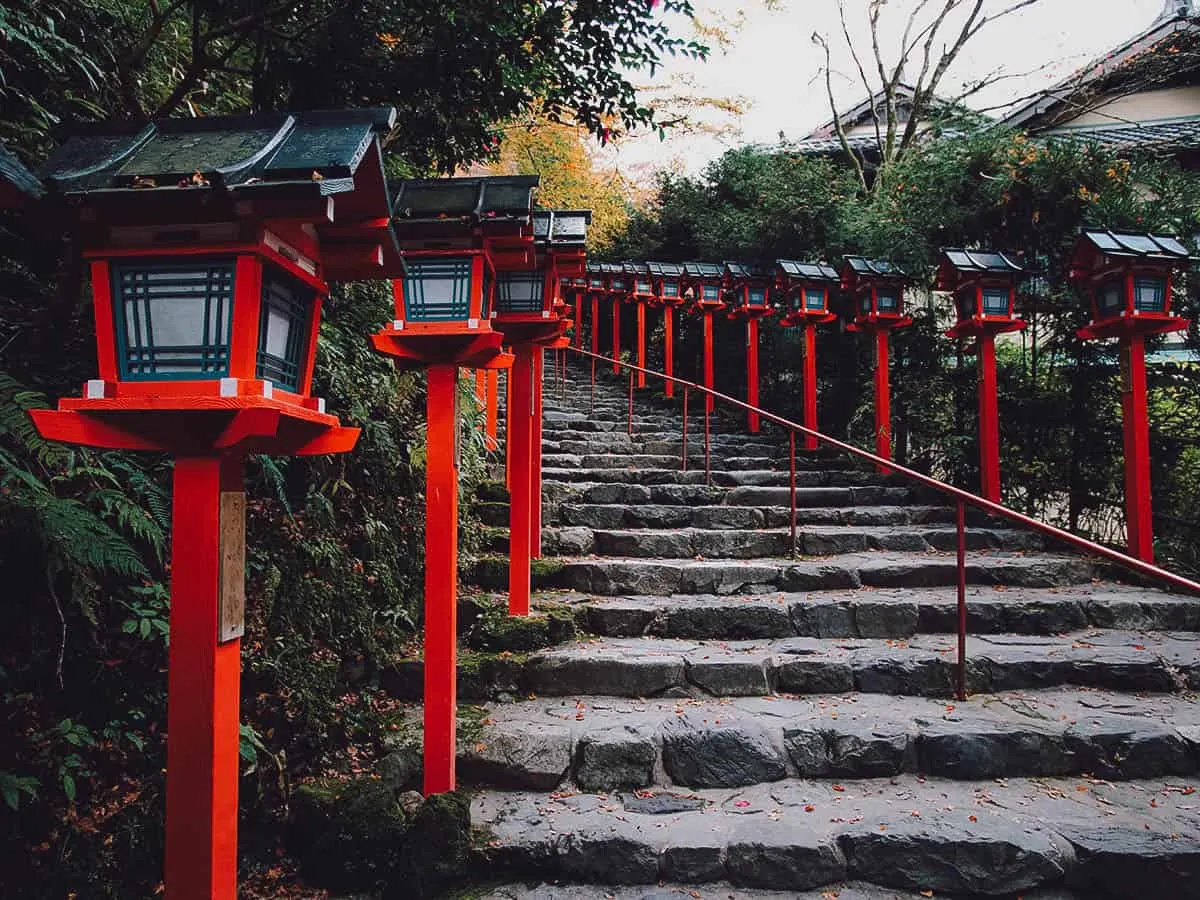
Photo by zzz555zzz via Shutterstock
2. Osaka
Travelers who love to eat can’t visit Kyoto without spending time in Osaka. If you’ll be flying in to Japan, then chances are you’ll be landing at KIX anyway which is just outside Osaka.
Less than half an hour from Kyoto, Osaka is often referred to as the “nation’s kitchen” and regarded by many as one of the best food cities in Japan. Like Kyoto, we absolutely love Osaka. Check out this Osaka travel guide to help you plan your trip.
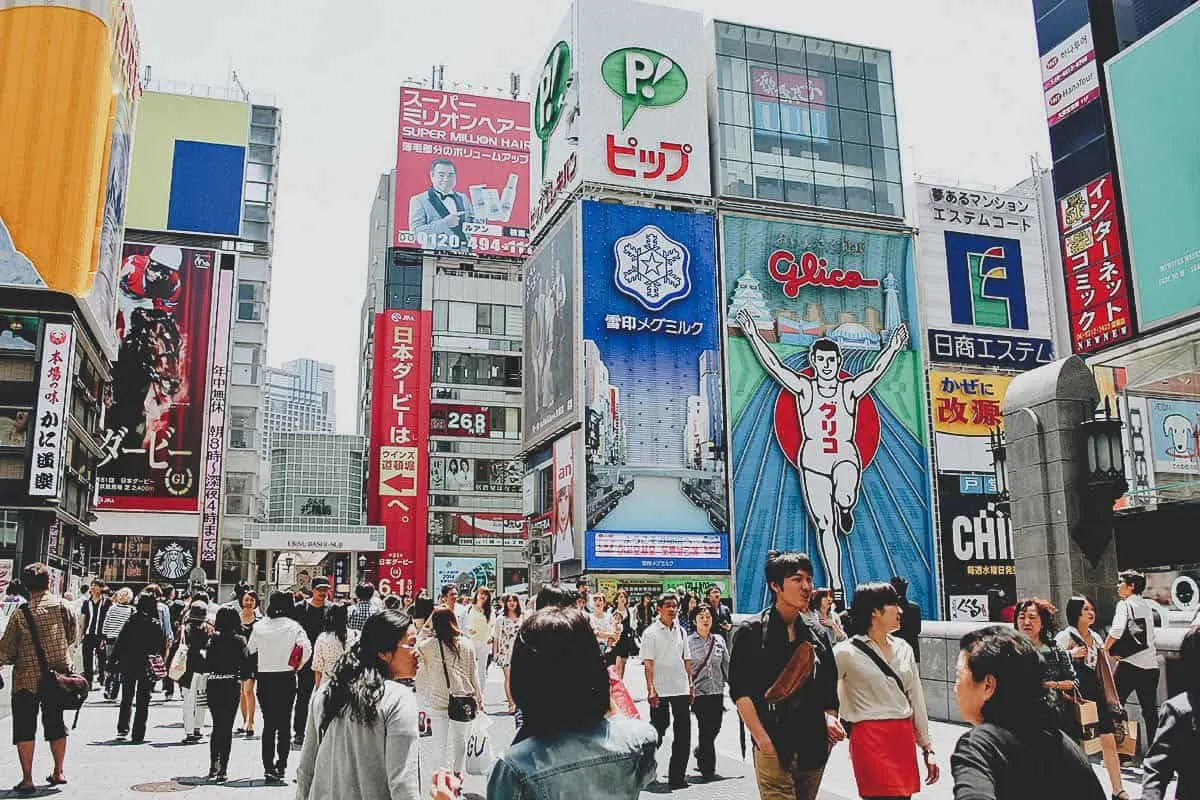
3. Nara
Nara is one of the “big three” most popular cities to visit in the Kansai region. It has the second most number of temples and shrines in Japan, behind only Kyoto. If you haven’t had your fill of temples in Kyoto, then you may want to spend a day in Nara.
Aside from its temples, Nara’s biggest draw is the small army of tame Sika deer that freely roam its parks. You can feed them sika senbei or “deer crackers”. Bow to the deer, and some will bow back to you.
Check out our day tripper’s travel guide to Nara to help you plan your trip. If you’d prefer to visit on a guided tour, then you can book one through Klook, Get Your Guide, or Magical Trip.
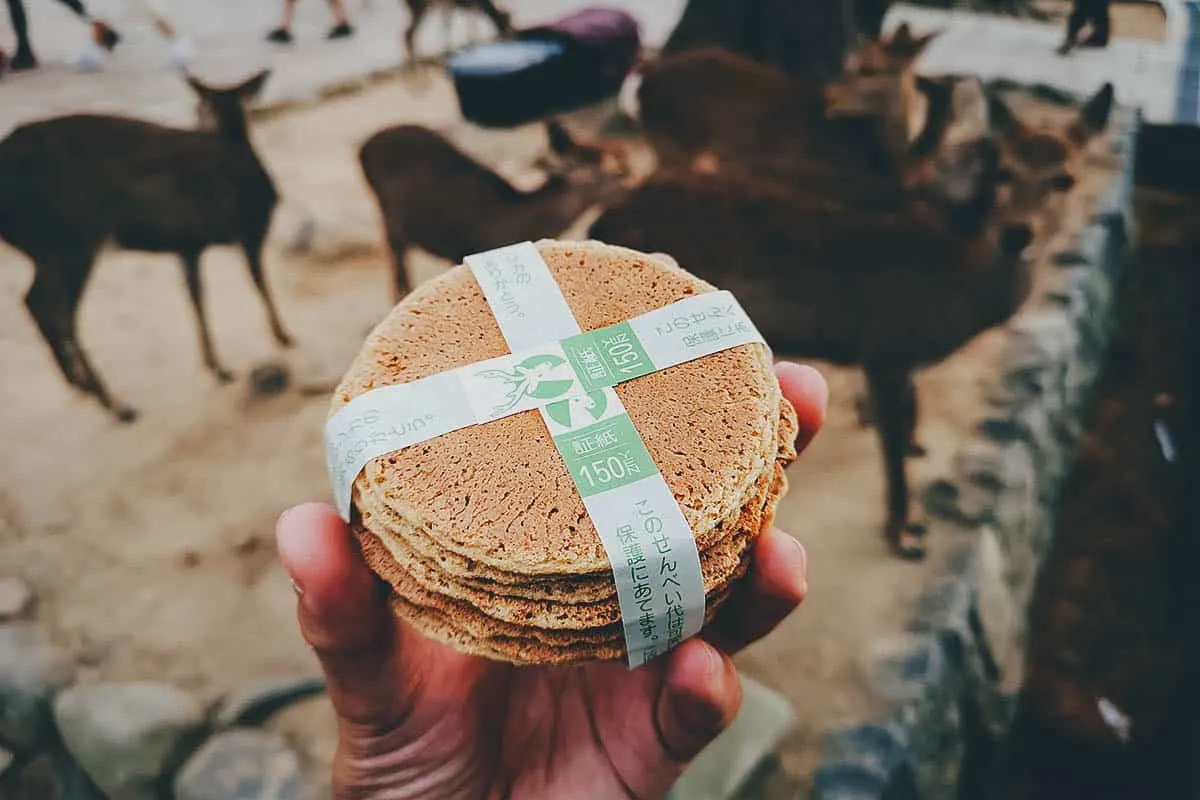
4. Kinosaki Onsen
I loved this place. Small onsen towns like Kinosaki and Kurokawa Onsen are some of the coolest places we’ve visited in Japan.
If you’d like to go onsen-hopping in a traditional hot spring town, then Kinosaki Onsen is one of the best places you can reach from Kyoto. It has seven soto-yus or public hot spring baths, all of which you can visit for JPY 1,300. You can check my article on Kinosaki Onsen for more pictures and information.
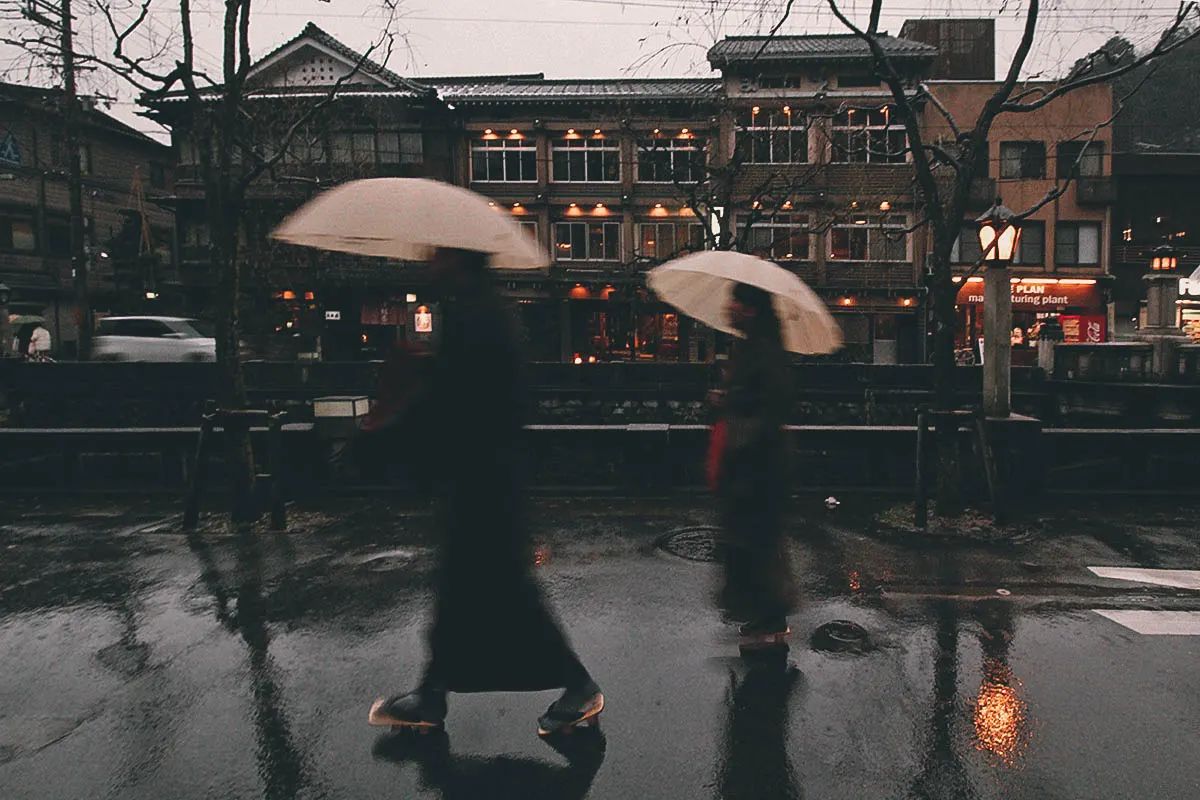
5. Amanohashidate
Amanohashidate is one of the three most scenic views in Japan. It’s a long and slender pine-covered sandbar that spans Miyazu Bay in northern Kyoto prefecture.
Measuring just 20 meters (66 ft) wide at its narrowest point, Amanohashidate is home to nearly 8,000 pine trees. There’s a walking trail on the sandbar that you can use to go from one side of the bay to the other, either on foot or by bicycle.
The sandbar is the main draw but there are plenty of temples, shops, restaurants, and cafes on either side of the bay to make this an interesting day trip. You can check my post on Amanohashidate for more pictures and information.
Amamnohashidate is about two hours north of Kyoto City. It’s possible to visit on a day trip but if you’d rather go on a guided tour, then you can book one through Klook.
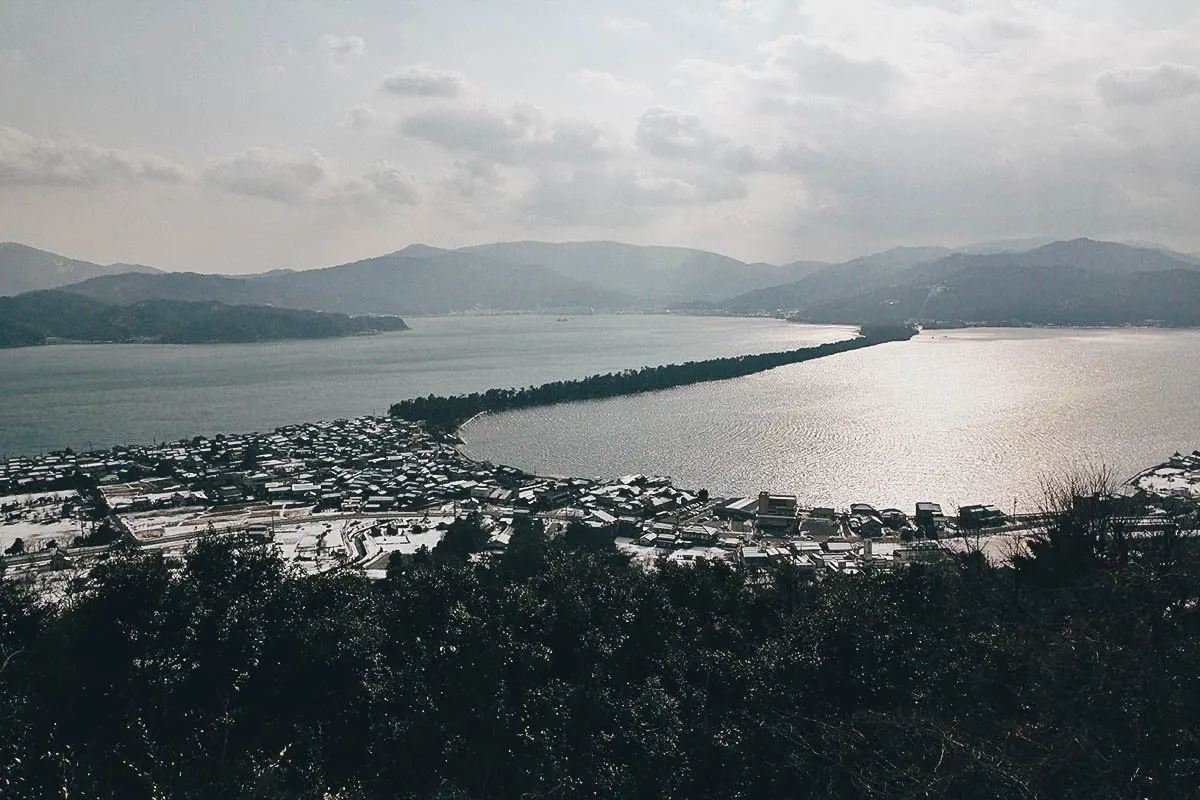
JAPANESE FOOD GUIDE
Japanese food is my absolute favorite cuisine in the world and a big reason why we love visiting this country. If you enjoy Japanese food and Japanese desserts as much as we do, then you might want to check out our Japanese Food Guide. It features popular dishes throughout Japan, including regional specialties by prefecture.
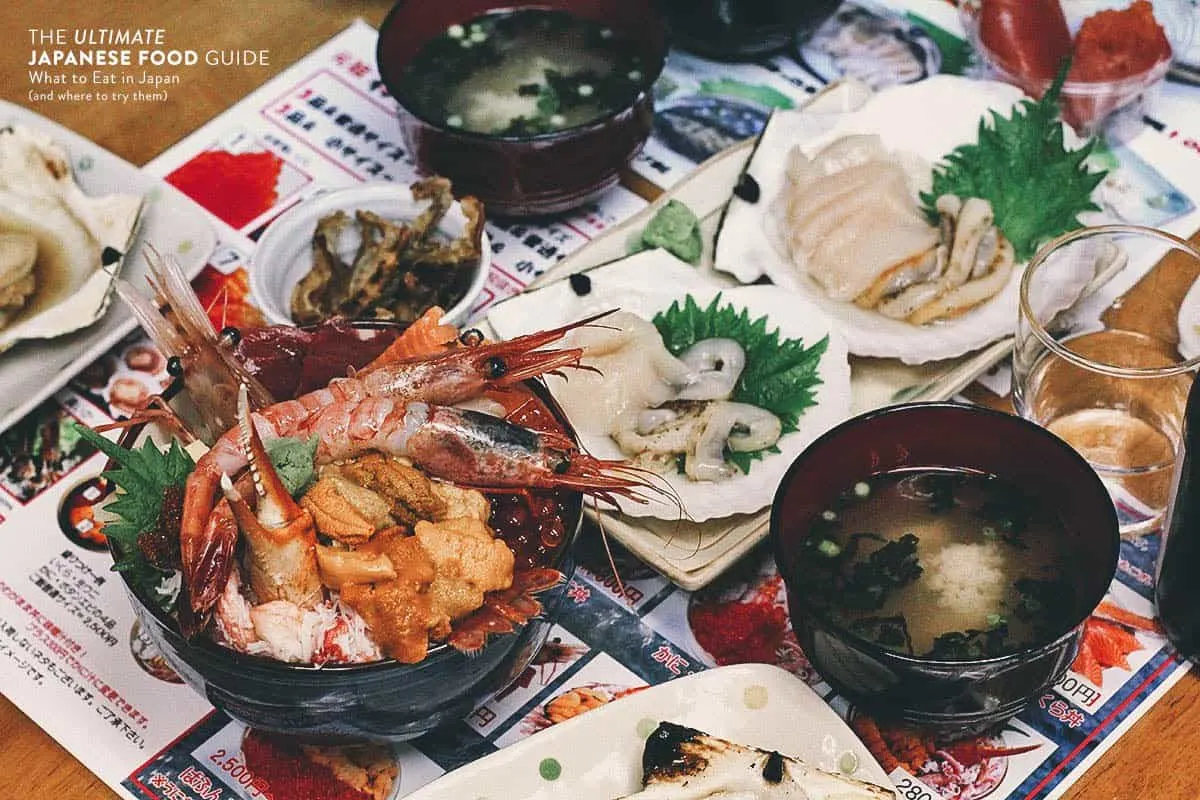
WHERE TO EAT IN KYOTO
Kyoto is home to the second most number of Michelin Stars in Japan, behind only Tokyo. There are plenty of great restaurants in Kyoto to have classic Japanese dishes like ramen, sushi, tempura, and more.
If you’re searching for the best places to eat, then check out our article on 14 of the best restaurants in Kyoto.
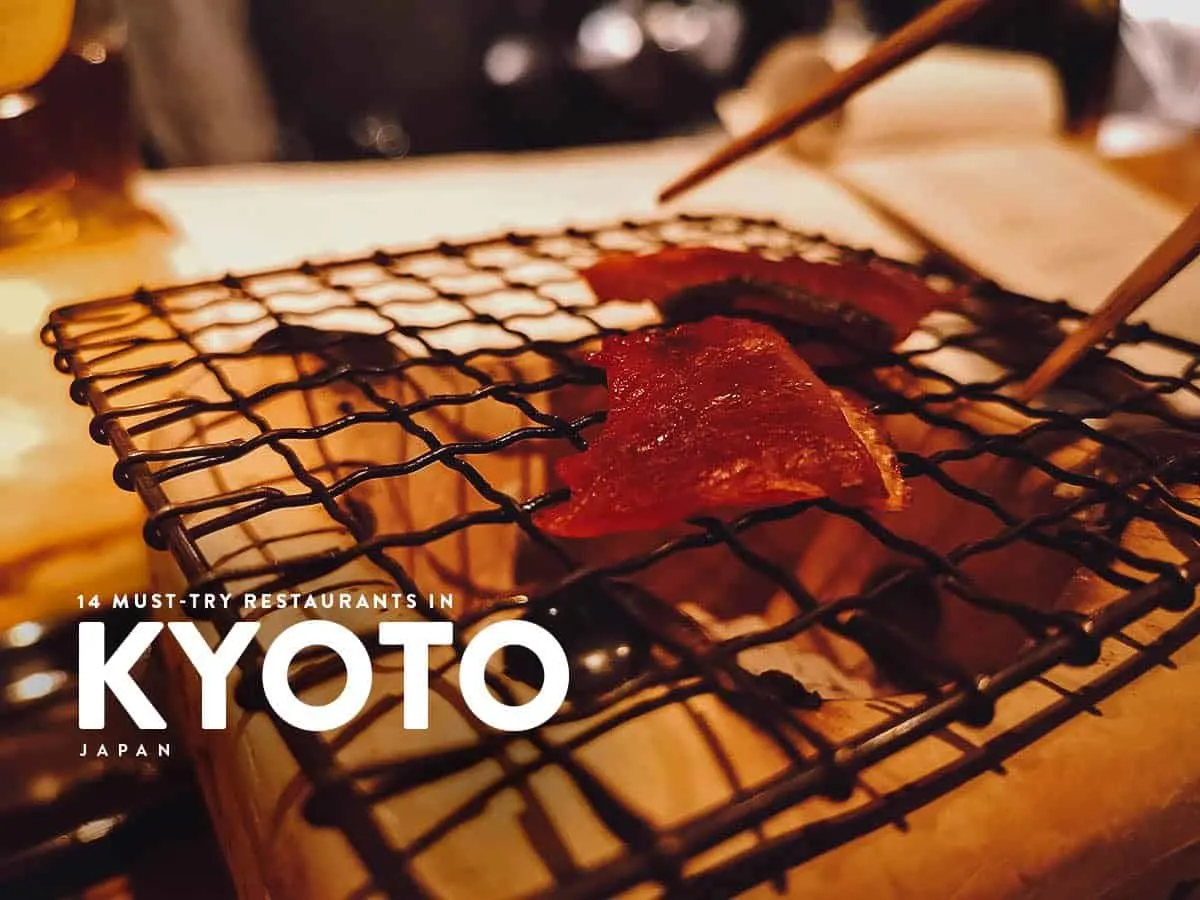
Fourteen may be too many for most travelers so I’ve listed five of our favorites below. Be sure to click through to the complete food guide for more pictures and information.
1. Wajouryoumen Sugari
Wajouryoumen Sugari gave me one of the best bowls of ramen I’ve ever had in Japan. I had the motsu tsukemen which is sort of like a deconstructed ramen served with offal.
Tsukemen refers to a type of ramen where the noodles and broth are served separately. This is done to keep the noodles nice and firm throughout your meal. To eat, you dip the noodles into the broth which is more intensely flavorful than typical ramen broth.
Motsu refers to offal like beef intestine or pork tripe. It’s the same type of organ meat used in motsunabe. If you like offal, then you absolutely need to try the motsu tsukemen at Wajouryoumen Sugari. I don’t know how common it is but this is the only place I’ve seen it so far in Japan.
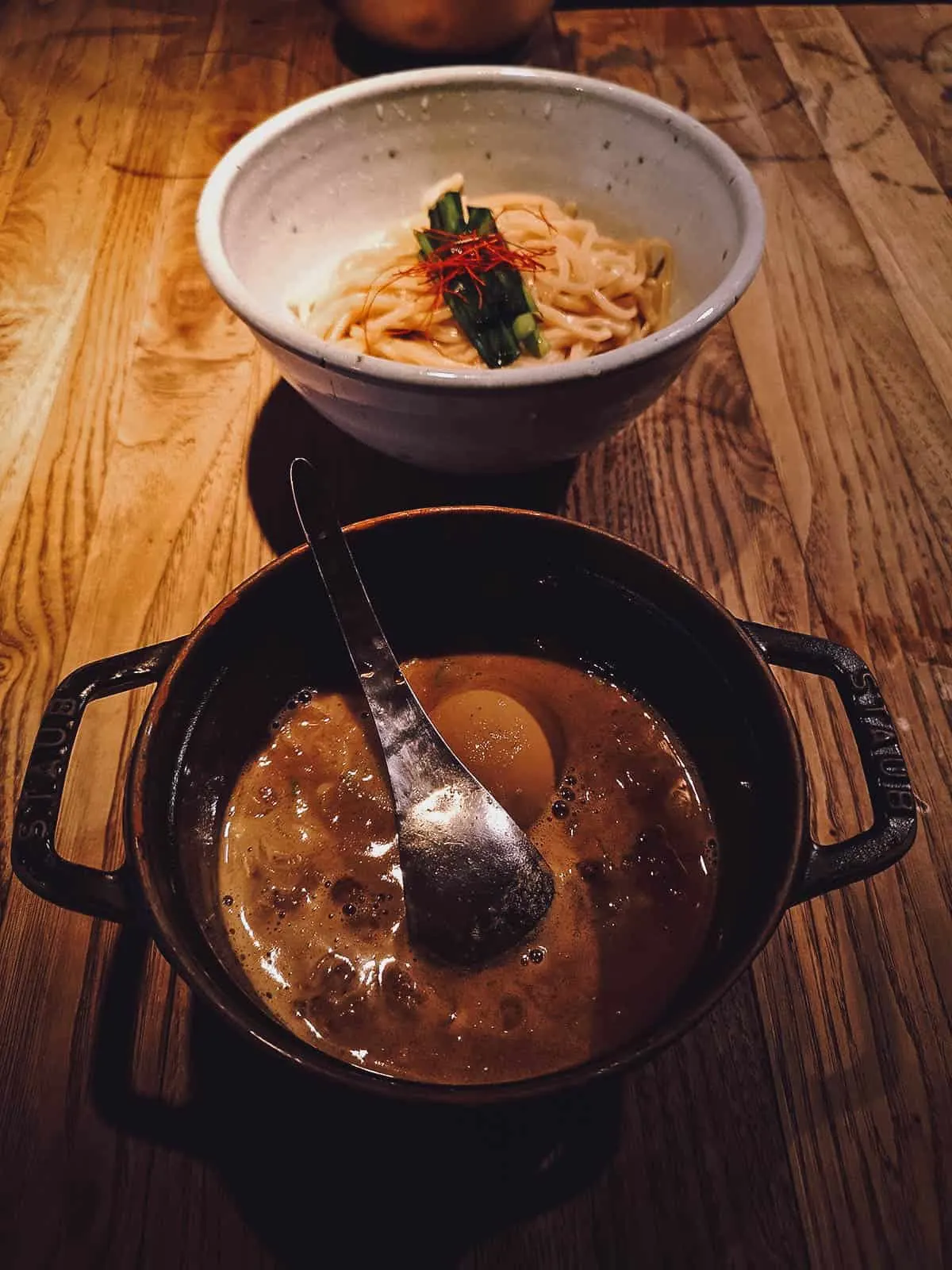
2. Hachidaime Gihey
Kyoto is considered the birthplace of kaiseki, which is a multi-course Japanese dinner consisting of small artfully prepared dishes. You can think of it as the Japanese version of western haute cuisine.
Hachidaime Gihey is known for serving good kaiseki dinners at reasonable prices. However, I was there for lunch to try one of their equally popular lunch sets. I asked my server for recommendations and she suggested I get the chicken karaage set. It came with an unlimited amount of rice which I believe is standard for all their lunch sets.
After you finish your rice, your server will ask if you’d like a refill. Say yes and you’ll get a second serving topped with a small portion of toasted rice seasoned with sesame and salt. It’s similar to the scorched socarrat rice in paella. Hachidaime Gihey is known for their different preparations of rice which you can enjoy in their kaiseki meals.
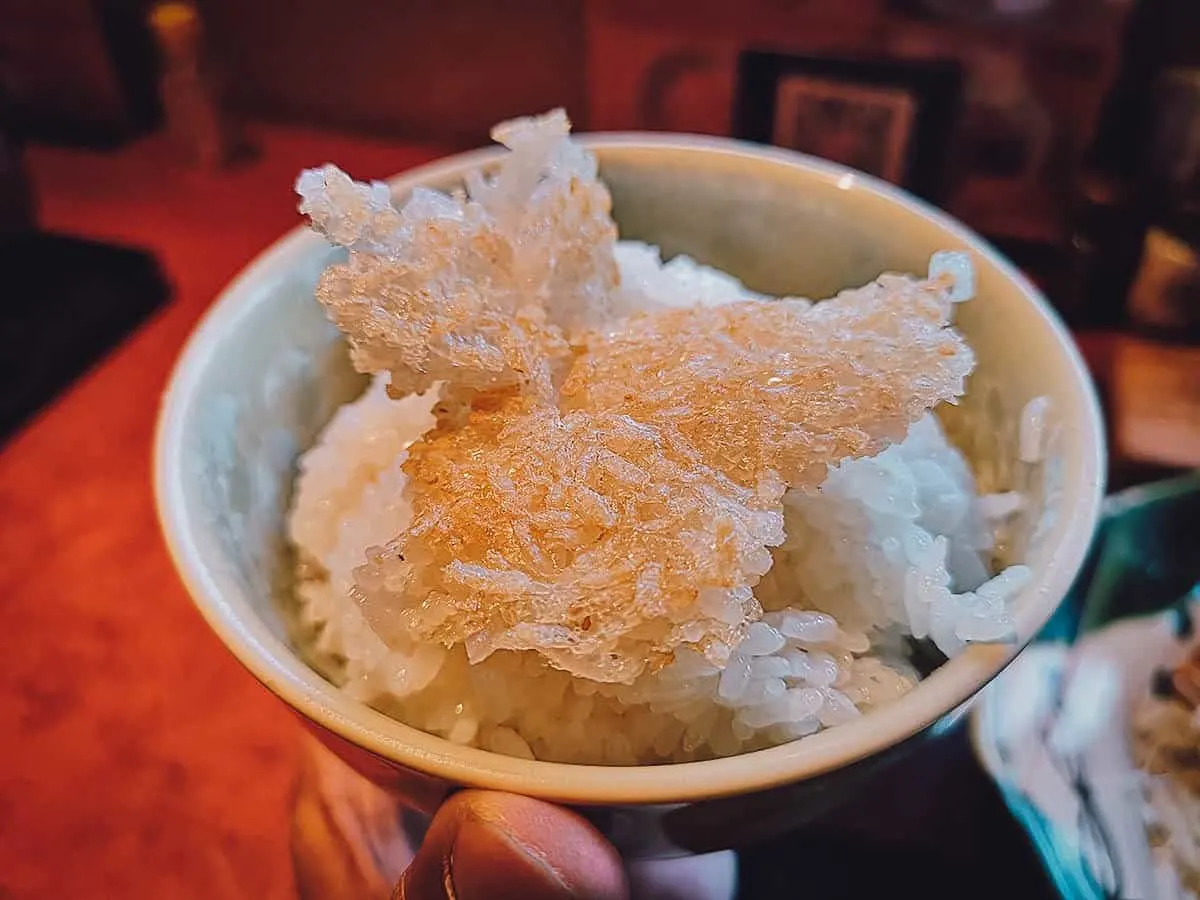
3. Unagi Hirokawa
We’ve eaten a lot of great food in Japan, but the one experience we were dying to have was unagi or grilled freshwater eel at an unagi kabayaki restaurant. We got to do that at Hirokawa, a former Michelin-starred unagi restaurant in Arashiyama. It was some of the best unagi we’ve ever had.
When we had lunch at Hirokawa, they were the proud owners of one Michelin Star but they seem to have lost it since then. They did close for many months to renovate so that may have something to do with it.
Whatever the reason, they’re still one of the best unagi restaurants in Kyoto. They’re immensely popular so advanced reservations are highly recommended.
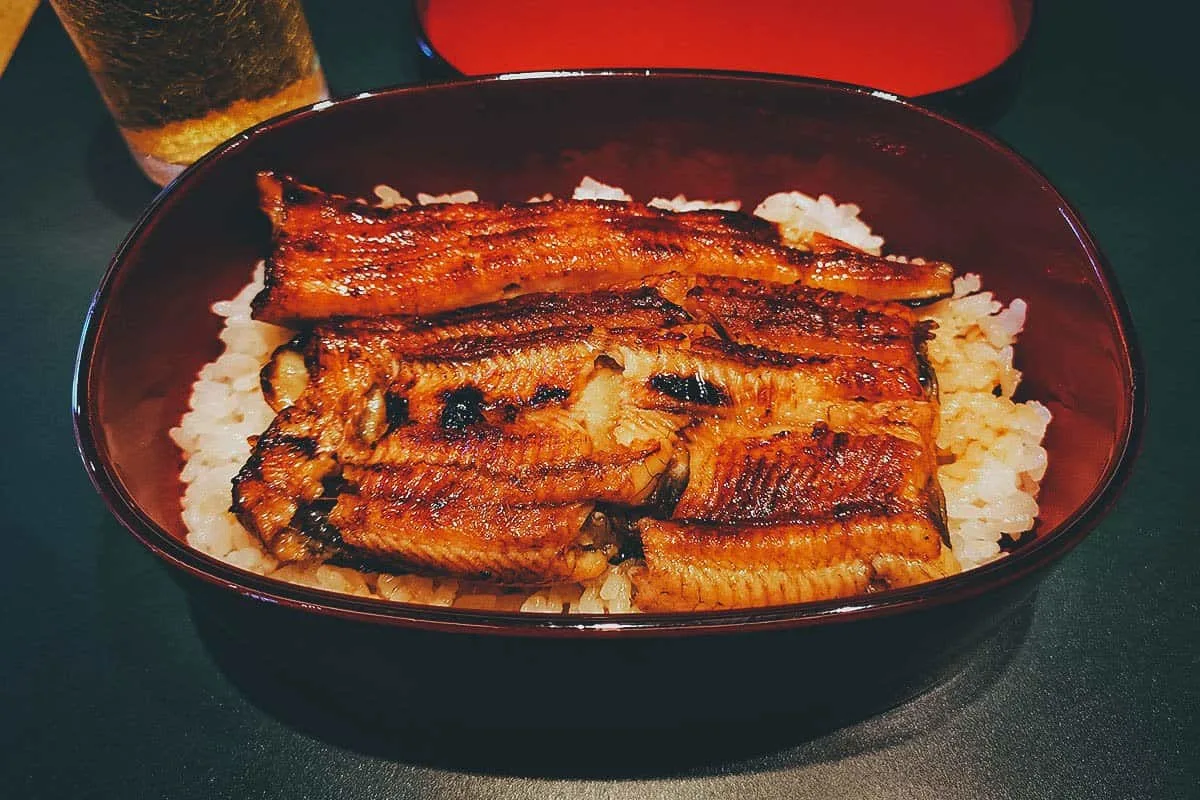
4. Gion Kappa Restaurant
Nestled in the heart of the Gion District, Gion Kappa is an izakaya and a local favorite. It was highly recommended to us for two reasons: 1) they serve good Japanese food; and 2) almost everything on the menu goes for just JPY 390.
Check out my article on Gion Kappa Restaurant for more pictures and information.
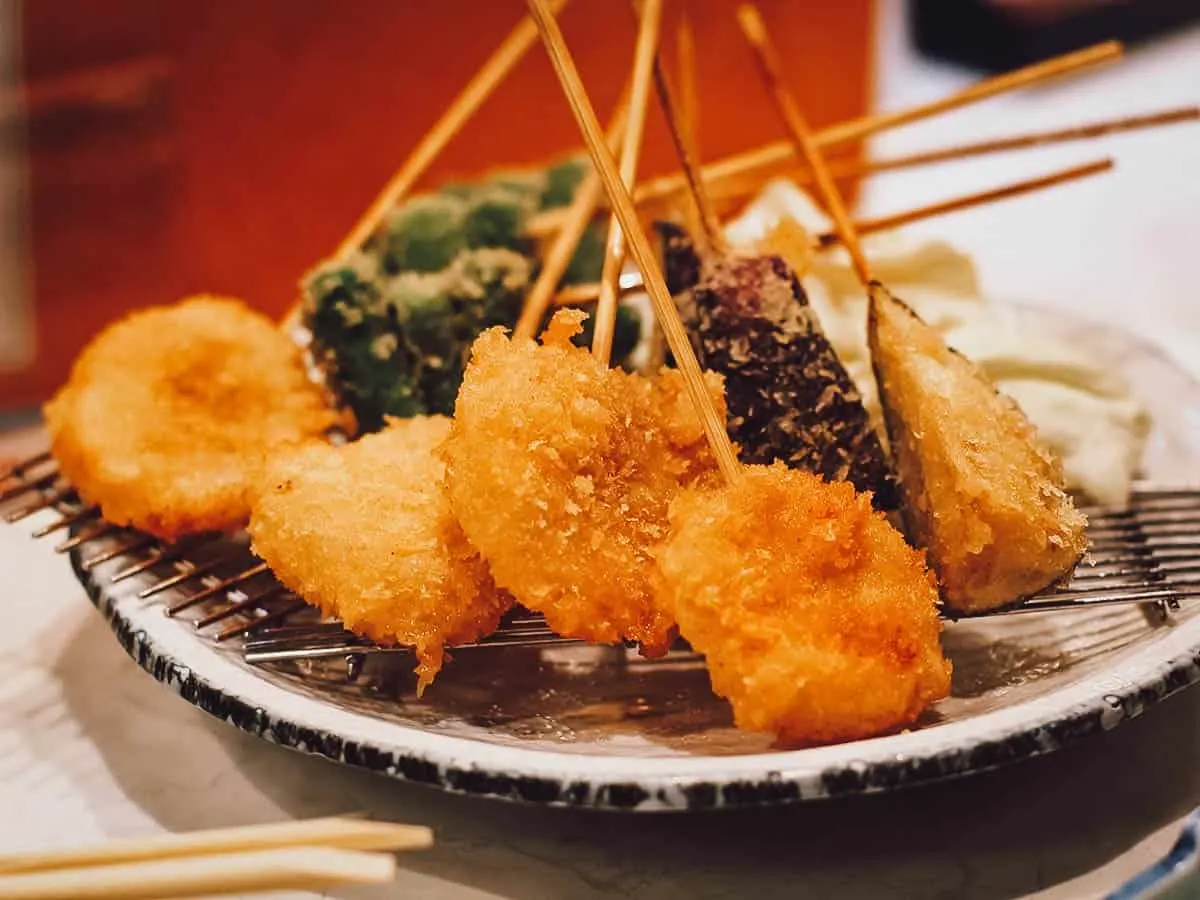
5. Wadachi
I wanted to find a good sake bar where we could unwind after a day of exploration in Kyoto and my research led us to Wadachi, an izakaya in the Gion District known for serving many different types of sake and bar food at affordable prices. If you enjoy sake, then Wadachi is a great choice for an evening out in Kyoto.
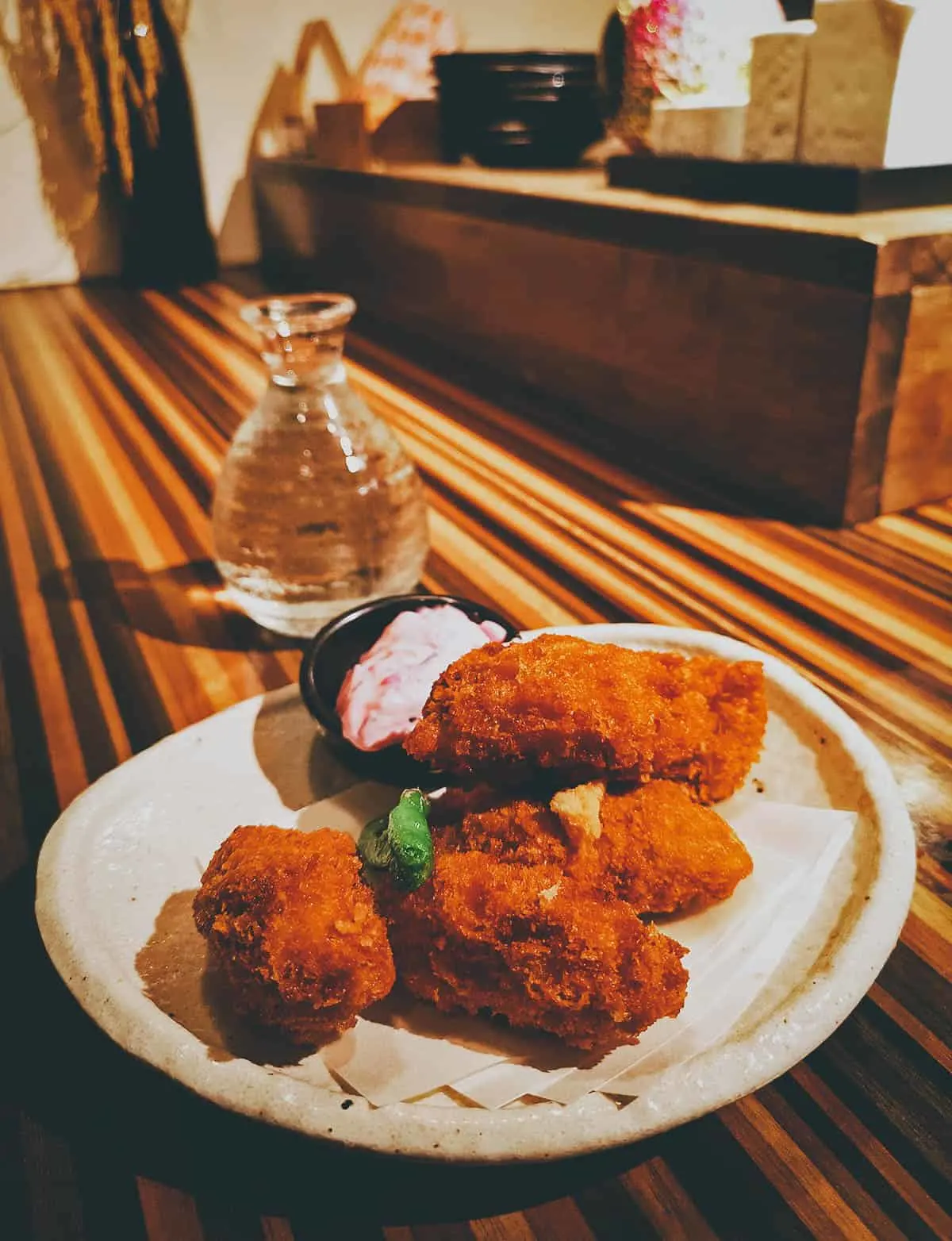
POINTS OF INTEREST IN KYOTO
To make it easier for you to visualize where everything is, I’ve pinned most of the places recommended in this guide on a map. Click on the link for a live version of the map.
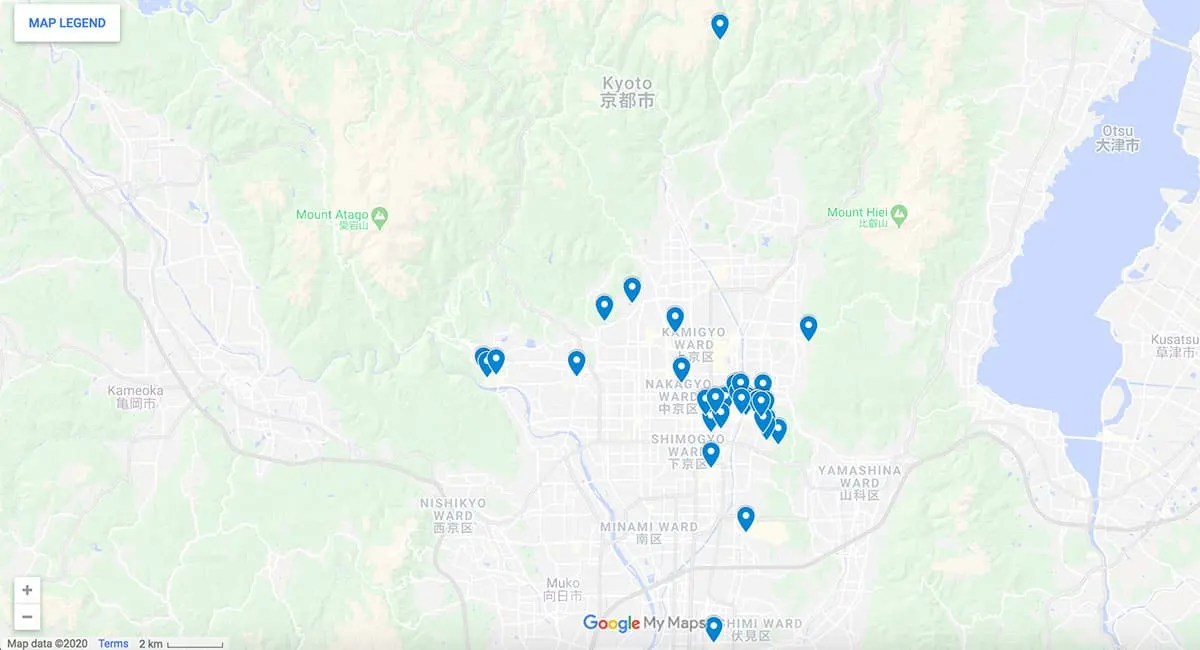
HOW TO GET AROUND IN KYOTO
Kyoto has a great public transportation system. You can get pretty much anywhere you want using the subway or bus. Be sure to bookmark hyperdia.com as it’ll help you navigate Japan’s efficient but often confusing rail system.
Personally, I prefer using the subway when we travel because I find buses to be more confusing. But in Kyoto, it may be best to use a combination of both. This is because some attractions aren’t that near a subway station.
For example, the nearest MRT station to Kinkaku-ji is Kita-oji, but it’s still over 3 km from the temple. Another example is Kiyomizu-dera. Kiyomizu-Gojo is the closest MRT station but it’s still about a 20-minute walk from the temple. If you only have a couple of days in Kyoto, then you’ll be wasting a lot of time walking if you try to get around exclusively by train.
To maximize your time in Kyoto, then it may be a good idea to get a transportation pass. There are a lot to choose from so I’ve narrowed it down to the most pertinent ones below to hopefully make it less confusing.
Kansai Thru Pass
If you’ll be traveling a lot by train around the Kansai region, then you may want to get a Kansai Thru Pass. It’s available in 2- or 3-day variants and gives you unlimited train and bus rides in cities throughout the Kansai area. Unlike JR Passes, you don’t have to use it on consecutive days. It isn’t valid for travel on JR trains but you can use it to go from KIX to Kyoto, as long as you ride only on non-JR trains. You can purchase the Kansai Thru Pass on Klook.
JR Kansai Area Pass
JR Kansai Area Passes are similar to Kansai Thru Passes except they’re for use on JR trains (including the Kansai Airport Express Haruka) and need to be used on consecutive days. However, I read that there are very few JR lines in Kyoto so this pass may not be your best option if you plan on spending most of your time in Kyoto. But if you plan on exploring more of the Kansai region, then this may be a good option. You can purchase the JR Kansai Area Pass on Klook.
ICOCA IC Card
Another transportation pass you can get is the ICOCA IC Card. It won’t entitle you to unlimited rides but it’ll give you discounts on JR trains (including the Kansai Airport Express Haruka), the subway, private railways, and buses. It’s rechargeable so you can think of it as a stored value card similar to Hong Kong’s Octopus Card. Click on the link for more information on Japan’s IC Cards.
JR Pass
If you’re doing a countrywide tour of Japan, then a JR Pass may be a worthwhile investment. It’ll give you unlimited rides on all JR national trains in Japan – including the Kansai Airport Express Haruka, Shinkansen bullet trains, and the Narita Express – for a consecutive number of days. It’s available in 7-, 14-, or 21-day variants and can be purchased through Klook or Japan Rail Pass.
HOW MANY DAYS TO STAY / KYOTO ITINERARY
As described, there is a lot to see and do in Kyoto. It’s a such a beautiful and peaceful city that it isn’t the kind of place you’ll just want to breeze through. If you have a whole week to spend there, then that’s great. But if not, then you should be able to see the major sights in about three days.
Here’s a quick 3D/3N Kyoto itinerary to help you plan your trip. Be sure to click through to our full 3-day Kyoto itinerary for more details.
| DAY ONE • Kiyomizu-dera • Sannen-zaka / Ninen-zaka • Yasaka Shrine • Gion District • Kamo River • Nishiki Market |
| DAY TWO • Arashiyama Bamboo Grove • Tenryu-ji • Ryoan-ji • Kinkaku-ji • Pontocho Alley |
| DAY THREE • Fushimi Inari Taisha • Nijo-jo • Ginkaku-ji • Gion District |
KYOTO TRAVEL TIPS
1. Plan your Trip with Sygic Travel
If you like creating your own travel itineraries, then you’re going to love Sygic Travel. I’ve been using this free trip planning app for several years now. It allows me to pin all points of interest on a map then group them together by location so I can create an efficient itinerary. It’s available for free on iOS and Android.
2. Stay Connected
Having a steady wifi connection is a must when traveling these days, especially in a country like Japan where there’s a significant language barrier.
The rail system is incredibly efficient but it can also be very confusing, which is why it’s so important to have uninterrupted access to the internet. You’ll need it to use Hyperdia which is essential to making sense of Japan’s rail system.
You can get access to the internet by renting a pocket wifi device or buying a sim card. We prefer pocket wifi devices because we find them simpler to use, but either is fine. You can arrange for them through Klook (pocket wifi | sim card) or Get Your Guide.
3. Bookmark Hyperdia or Get the App on your Mobile Device
I can’t stress how helpful Hyperdia is when navigating through Japan’s efficient but confounding railway system. Not only will it give you precise train arrival and departure times, but it’ll tell you exactly how to go from one station to the next. It makes it so much easier so be sure to download the app or bookmark the website on your mobile device. It’ll be you new best friend in Japan.
WEBSITE: hyperdia.com
4. Check for Kyoto Travel Deals
I buy discount vouchers from many websites, but for Japan, my favorites are Klook and Get Your Guide. They often offer the widest selection at the best prices.
If you want to find deals on tours, airport transfers, pocket wifi rental, etc, then you can check what’s available on Klook and Get Your Guide. I often find cool activities that I wouldn’t think of myself so it’s always worth a look.
5. Get Travel Insurance
People have differing opinions when it comes to travel insurance. Many don’t think they need it but for me, it depends on where you’re going and what you’ll be doing.
If we plan on doing anything physical like riding bikes or skiing, then I’ll definitely get it. I don’t want to break my leg on a mountain and not have insurance!
But if all we’ll be doing is eating and visiting temples for a few days like we did in Kyoto, then I probably won’t get it. The decision is yours.
When we do feel the need for it, we get insurance from SafetyWing or Heymondo. They’re travel insurance providers frequently used by many long-term travelers. You can click on the links to get a free quote from SafetyWing or Heymondo. Get 5% off on Heymondo when using our link.
6. Get Comfortable Shoes
This may seem self-explanatory but you’ll be doing a lot of walking in Kyoto so comfortable shoes are a must. Many of the sites are vast and spread out, so comfort and support for your feet are paramount. For convenience, I suggest wearing slip-ons as well because you’ll be taking them off frequently at temples.
7. Bring the Right Power Adapter
Japan has Type A or Type B electrical outlets so be sure to bring the right power adapters for your devices. Electrical voltage is 100V and the standard frequency is 50/60Hz.
8. Learn Basic Japanese Etiquette
Japan is a country of many unwritten rules. It’s easy to commit a cultural faux pas here so it’s best to familiarize yourself with the basics. Before your trip, I suggest checking out this good overview on Japanese etiquette for tourists.
Have Fun!
I’m definitely not an expert on Kyoto but I do hope that this guide helps you plan your trip. I’m only sharing some of the things that I’ve learned from our visits there. If you have any questions or suggestions, then please leave them in the comment section below.
Thanks for stopping by and have a great time exploring the beauty of Kyoto!
Disclosure
This Kyoto travel guide contains affiliate links, meaning we’ll get a small commission if you make a booking at no additional cost to you. We only recommend products and services that we use ourselves and firmly believe in. We really appreciate your support as this helps us make more of these free travel guides. Thank you!


Eraser
Monday 3rd of February 2020
muy útil!! desde México, sayonara!
JB & Renée
Tuesday 4th of February 2020
Gracias, desde Kyoto!
Khalid
Tuesday 31st of December 2019
Thank you for the great blog
JB & Renée
Thursday 2nd of January 2020
You're welcome Khalid. Enjoy Japan. :)
Ali
Monday 30th of December 2019
Great article and website, thanks!
JB & Renée
Tuesday 31st of December 2019
Thanks Ali! Happy to hear you found the article useful. :)
JB & Renée
Tuesday 19th of February 2019
@LemonCalamansi: Happy you found it useful! :)
LemonCalamansi
Monday 18th of February 2019
this is very helpful!